Toyota Prius
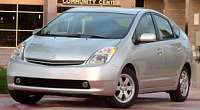
Hybrid powertrain, which incorporated both
petrol engine and electric motor, appeared many years ago in show cars.
Its objective is to reduce emission as well as fuel consumption through
the following mechanism : during acceleration, the stronger petrol engine
provides the power, then the electric motor will take over in higher
speed, it will also generate electricity and charge up the batteries
during braking, thus make good use of the energy that conventional car
loses.
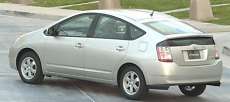
Toyota
became the first car maker to put "Hybrid car" in production by launching
Prius in December 1997. At first, it is only for sale in Japan in a small
volume, but strong reaction may lead to its appearance in foreign markets,
especially is environmental conscious
California.

Prius uses
a compact hybrid power unit, in which the straight four 1.5 litres engine
is mated inline with the d.c. motor and driving the front wheel. The
petrol engine is of Toyota's latest lean burn technology, which provides
remarkable emission and fuel consumption even without the aid of the
electric motor. A complex planetary transmission offers smooth transition
between the engine and the motor. 40 pieces of Ni-MH batteries store the
energy for motor use, they alone may not provide enough range, but during
normal use they will be frequently charged up by the energy generated by
braking so that the car can travel no shorter than conventional petrol
cars.
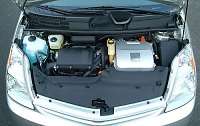
Compare
with fully electric cars like GM EV1 and Honda EV Plus, Prius has the
advantage of long range and no-charging time needed, that makes it far
more practical. Compare with petrol cars, it is slower due to the
additional weight of the batteries and electric motor, but it burns a
friction fuel and offers superior emission just next to electric cars,
that seems to be very attractive in the
future.
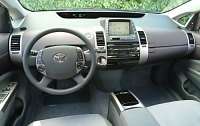
Besides
the power unit, Prius offers as much interior space as Corona despite of
the Corolla-size external dimensions, thanks to the long wheelbase and
short overhangs. Dashboard and central console is futuristically styled.
Satellite navigation is provided in domestic market. It is the most
practical green car until now.
|
Model |
Prius |
- |
- |
|
Layout |
Front-engined,
Fwd |
- |
- |
|
L / W / H / WB
(mm) |
4445 / 1727 / 1488 /
2692 |
- |
- |
|
Engine |
Inline-4, dohc, 4v/cyl,
VVT,
DI / 500V AC electric
motor |
- |
- |
|
Capacity |
1496
cc |
- |
- |
|
Power (engine / motor /
combine) |
78 hp / 67 hp / 108
hp |
- |
- |
|
Torque (engine /
motor) |
85 lbft / 295
lbft |
- |
- |
|
Transmission |
CVT |
- |
- |
|
Suspension
(F/R) |
strut /
torsion-beam |
- |
- |
|
Tyres
(F/R) |
N/A |
- |
- |
|
Weight |
1295
kg |
- |
- |
|
Top
speed |
105 mph
(est) |
- |
- |
|
0-60
mph |
10.5 sec
(est) |
- |
- |
|
0-100
mph |
N/A |
- |
- |
Toyota Avensis
 Avensis is a
typical Toyota product. Reliable, well-built, comfortable, easy to
drive.... but it also associates with descriptions such as "ugly",
"uninspiring", "lack of character" etc. In short, very
Toyota-like. Avensis is a
typical Toyota product. Reliable, well-built, comfortable, easy to
drive.... but it also associates with descriptions such as "ugly",
"uninspiring", "lack of character" etc. In short, very
Toyota-like.
This is not a great way to
introduce the new Avensis, but I am really tired of such Toyotas after
watching cars for many years. Toyota, in some way like GM, cares too much
about customer surveys thus its mainstream cars are usually lack of a
clear design and engineering philosophy. But the most disappointing is
that they still do the styling wrong. By all standards, Avensis is an ugly
design. It looks bulky, dull and boring. Its body language tells you that
the driver inside must be Mr. Average.
The Avensis was engineered
mostly in Japan base on the Allion / Corona Premio architecture (the duo
was launched about a year before the Avensis). However, it has the rear
suspensions upgraded to the Celica’s double-wishbones setup and the ride
and handling was sorted out on European roads (by Lotus, if Toyota didn’t
tell you). Yes, I almost forget to tell you that the Avensis is built in
UK and supplies only the European market, therefore care has been taken to
make sure it handles and rides like a European car. The chassis is about
in the same size as rivals, with a 2700mm wheelbase and tall roof to
achieve a roomy cabin. The engines include a 1.6 VVT-i, a 1.8VVT-i, a
direct-injection 2.0D-4 petrol and a 2.0D4-D common-rail turbo diesel.
Cheaper models employ electric power steering while the top petrol and
diesel model use conventional hydraulic assistance to ensure better road
feel.
In terms of performance, the
Avensis is rather disappointing. Autocar conducted a group test against
Ford Mondeo, Mazda 6, Honda Accord and Renault Laguna and found the
Avensis was the slowest. Despite of variable valve timing and direct
injection technology, despite of 147 horsepower, the 2.0D4 engine fails to
provide sparkling performance. Moreover, the engine sounds coarse and
noisy under stress, which is disappointing by the engineering standard of
Toyota.
In terms of ride and handling,
the new Avensis is competent but never outstanding. It feels more like a
European car than even some European rivals, such as Renault Laguna and
Volkswagen Passat. The hydraulic steering in top models is responsive and
provides crisp turn-in, if not specially good communication. As the
suspension is set firmer than Japanese norm, Avensis has its body control
very well in most circumstances. However, "most circumstances" does not
include extreme conditions. If you rush into corners, weight transfer at
the tail will build up suddenly and destroy your confidence. In short,
Avensis is not as good a driver's car as Ford Mondeo, Mazda 6 and European
Honda Accord.
The best thing is probably the
cabin. It employs Volkswagen-grade soft-touch plastic and is screwed
together as solidly as Lexus. The center console is surfaced with real
metal, not metal-effect plastic. The cabin is roomy, although rear
accommodation is ultimately not as big as Mondeo. 520 litres of luggage
room is simply class-leading. However, the cabin is short of styling and
character, just like the car itself. Mr. Average might like it, but we
don't.
Toyota Allion and Premio
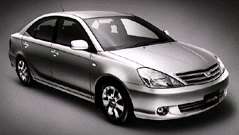 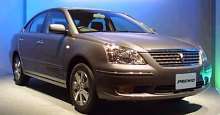
Toyota
launched the Allion and its twins sister Premio in December 2001. Both are
bounded in the domestic market thus are less well known overseas. They are
basically the same car, just with different packaging. The Premio still
goes the conservative route while the Allion (means "all in one", oddly)
looks more sporting.
The Allion is smaller than the
Avensis to which it derived. To meet the lower taxation class, its width
is limited to 1.7 meters, virtually the same as the smaller Corolla. In
fact, the Allion is merely longer than the Corolla and have a 100mm longer
wheelbase. It even shares the same semi-independent torsion-beam axle rear
suspension with the Corolla. In contrast, its European cousin, Avensis,
employs a more expensive double-wishbone suspension instead. The same goes
for other derivatives, Avensis Verso (the MPV), Caldina (the sport estate)
and the next generation Vista sedan - all uses the higher-spec suspension.
That’s why I name Avensis as the representative of this platform although
Allion was launched earlier.
3 engines are available to
Allion: 1.5-litre (109hp), 1.8-litre (132hp) and 2.0-litre (152hp). All
have VVT-i and the 2.0-litre also has D-4 direct-injection. No manual
gearbox for domestic version. The top model is equipped with CVT while the
other two have 4-speed automatic.
Toyota Caldina
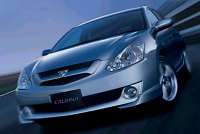 Talking about 4-wheel-drive performance estates, you might think of Audi RS4 or S4
Avant. In Japan, there are more choices, also at lower price - Subaru
Legacy GTB, Mitsubishi Legnum VR4 and Toyota
Caldina.
Talking about 4-wheel-drive performance estates, you might think of Audi RS4 or S4
Avant. In Japan, there are more choices, also at lower price - Subaru
Legacy GTB, Mitsubishi Legnum VR4 and Toyota
Caldina.
The new Caldina is derived
from the Avensis platform, with the same 2700mm wheelbase. However, if we
consider only the hottest model Caldina GT-4 - the most interesting model
to me, we can find it owes very much to the last generation Caldina GT-T.
Basically, the engine and 4-wheel-drive system are carried over from the
old car, which in turn took the mechanicals from the mighty Celica
GT-4.
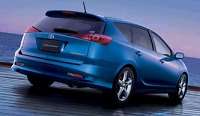 The engine is a 1998cc 16V Turbo,
pumping out 260hp and 239lbft, unchanged from the old car. The 4WD system
employs viscous coupling to distribute power between front and rear axle,
in addition to a Torsen limited-slip differential between the rear wheels.
Again, this is the same as the old Caldina and Celica GT-4. Transmission
remains just a 4-speed automatic, although it gets manual shift
pattern. The engine is a 1998cc 16V Turbo,
pumping out 260hp and 239lbft, unchanged from the old car. The 4WD system
employs viscous coupling to distribute power between front and rear axle,
in addition to a Torsen limited-slip differential between the rear wheels.
Again, this is the same as the old Caldina and Celica GT-4. Transmission
remains just a 4-speed automatic, although it gets manual shift
pattern.
However, compare with the old
car there are still a lot of new items. Most notably is the sharper and
handsomer new look, the much higher quality interior and the introduction
of double-wishbone rear suspensions from the current
Celica.
Lesser models are powered by a
152hp 2-litre 16V engine (which has no relationship with the turbo engine)
with direct injection, or a 132hp 1.8-litre 16V engine, both with VVT-i.
The 1.8 unit is for FWD only.
|
Model |
Avensis 2.0 D-4 |
Allion 2.0 D-4 |
Caldina GT-4 |
|
Layout |
Front-engined,
Fwd |
Front-engined,
Fwd |
Front-engined,
4wd |
|
L / W / H / WB
(mm) |
4630 / 1760 / 1480 /
2700 |
4550 / 1695 / 1470 /
2700 |
4510 / 1740 / 1445 /
2700 |
|
Engine |
Inline-4, dohc, 4v/cyl,
VVT,
DI. |
Inline-4, dohc, 4v/cyl,
VVT,
DI. |
Inline-4, dohc,
4v/cyl,
turbo. |
|
Capacity |
1998
cc |
1998
cc |
1998
cc |
|
Power |
147
hp |
152
hp |
260
hp |
|
Torque |
144
lbft |
147
lbft |
239
lbft |
|
Transmission |
5M |
CVT |
4A |
|
Suspension
(F/R) |
strut /
double-wishbone |
strut /
torsion-beam |
strut /
double-wishbone |
|
Tyres
(F/R) |
All: 205/55
R16 |
All: 195/65
R15 |
All: 215/45
ZR17 |
|
Weight |
1375
kg |
1240
kg |
1480
kg |
|
Top
speed |
127 mph
(c) |
N/A |
N/A |
|
0-60
mph |
9.4 sec
(c) |
N/A |
N/A |
|
0-100
mph |
N/A |
N/A |
N/A |
Toyota Camry
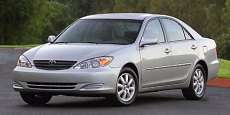 Look at the new Camry, you won't love it from first sight, nor you
will hate it. It is as unadventurous and inoffensive as its 3
predecessors. If you have to praise it, you can still say the new Camry
looks a bit more sexy than ever, with sleeker lines running from nose to
tail. The slippery profile not only contributes to a good Cd. of 0.28 but
also hides its extra dimensions very well - now it offers more head room
and rear passenger legroom, thanks to 50mm longer wheelbase and 64mm
higher roof. Like the cold-war USA and USSR, Camry fights hard with Honda
Accord in "space race". Look at the new Camry, you won't love it from first sight, nor you
will hate it. It is as unadventurous and inoffensive as its 3
predecessors. If you have to praise it, you can still say the new Camry
looks a bit more sexy than ever, with sleeker lines running from nose to
tail. The slippery profile not only contributes to a good Cd. of 0.28 but
also hides its extra dimensions very well - now it offers more head room
and rear passenger legroom, thanks to 50mm longer wheelbase and 64mm
higher roof. Like the cold-war USA and USSR, Camry fights hard with Honda
Accord in "space race".
This
fourth generation car is said to have a new platform, however, you will
find the Highlander SUV and sister car ES300 have already stolen its
debut. Expect Avalon / Pronard, Solara coupe and Sienna MPV to join this
platform as well. Yes, it might be new, but by no means revolutionary.
Most disappointing is that it still rides on MacPherson struts at each
corner, while most rivals (bar the GM ancient designs) are already
employing multi-link. However, improvements to chassis rigidity and
suspension calibration do enhance handling and refinement - maybe most on
the latter. NVH level is lowered, ride is supple, making the Camry a
smooth, quiet and refined family sedan as it once renowned
for.
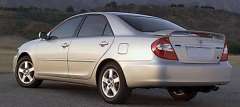 Good refinement
also comes from engines. Center of limelight is a new 2.4-litre
four-cylinder. With twin-balancer shafts it runs almost as smooth as a V6.
157 horsepower is not big number, but the adoption of VVT-i enhance torque
delivery across a wide band, making it an easy-going companion. The engine
is made of aluminium block and head, with magnesium cam cover and plastic
intake manifold to make the lightest in class. Good refinement
also comes from engines. Center of limelight is a new 2.4-litre
four-cylinder. With twin-balancer shafts it runs almost as smooth as a V6.
157 horsepower is not big number, but the adoption of VVT-i enhance torque
delivery across a wide band, making it an easy-going companion. The engine
is made of aluminium block and head, with magnesium cam cover and plastic
intake manifold to make the lightest in class.
In
comparison, the 3-litre V6 is rather disappointing. Without VVT-i, output
remains unchanged at 192hp and 209 lbft, which has long been overtaken by
rivals. Although refinement is good, its extra weight over the nose make
it less nimble to handle than the four-pot, while advantage in performance
is not big. So the 2.4 is still my choice.
 Of course, if our
choices are not limited to Toyota (some people only trust Toyota's
reliability and good servicing), Ford Mondeo is still the first priority.
Although we said the new Camry has improved handling, with linear and
accurate steering, tauter control and strong brakes, it is still a car
designed for comfort and driving ease rather than driving fun. Mrs.
Robinson and Mr. Grey might enjoy that kind of fuss-free driving, but
those who really Love driving will find the steering still lack of
feedback, body control is not good in twisty roads and it tends to
understeer early. In short, it does not feel as agile as the best European
sedans as well as Nissan's new Altima. Of course, if our
choices are not limited to Toyota (some people only trust Toyota's
reliability and good servicing), Ford Mondeo is still the first priority.
Although we said the new Camry has improved handling, with linear and
accurate steering, tauter control and strong brakes, it is still a car
designed for comfort and driving ease rather than driving fun. Mrs.
Robinson and Mr. Grey might enjoy that kind of fuss-free driving, but
those who really Love driving will find the steering still lack of
feedback, body control is not good in twisty roads and it tends to
understeer early. In short, it does not feel as agile as the best European
sedans as well as Nissan's new Altima.
Nevertheless, I guess Toyota cares little about that. The
successful history of Camry (American best selling car from 1997 to 2000)
proves that American care most about space and comfort. The new Camry has
plenty of them. No matter whether I like it, it will be another sale
success.
Lexus ES300 / Toyota Windom
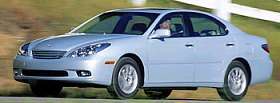 I want to write more about the new ES300, but I can't. Since the
car is still derived directly from the mainstream Camry, it is as
technically uninteresting as its 2 predecessors. How uninteresting ? first
of all, it is the last car in the world riding on MacPherson struts at
each corner while dare to declare itself as a prestige car. For the cheap
Camry, this is forgivable, but for Lexus it sounds like a joke. Well, many
BMW uses struts up front and Alfa 156 uses them at rear axle, but at both
front and rear ? ES300's chassis is the last breed of Jurassic
dinosaur. I want to write more about the new ES300, but I can't. Since the
car is still derived directly from the mainstream Camry, it is as
technically uninteresting as its 2 predecessors. How uninteresting ? first
of all, it is the last car in the world riding on MacPherson struts at
each corner while dare to declare itself as a prestige car. For the cheap
Camry, this is forgivable, but for Lexus it sounds like a joke. Well, many
BMW uses struts up front and Alfa 156 uses them at rear axle, but at both
front and rear ? ES300's chassis is the last breed of Jurassic
dinosaur.
It seems
that most improvements were done to enhance refinement and quietness, most
notably is by strengthening chassis, upgrading engine-mount and increasing
sound-deadening materials. In this respect, the ES300 still lives up to
Lexus' standard, but no longer feels as outstanding as its predecessor a
few years ago. That said, competitors have closed the gap or some even
surpassed it. In terms of ride quality, the old suspension shows its limit
here, offering a floaty ride over undulation. Optional 4-stage adaptive
damping actually improves ride and injects more driver appeal at the
stiffest setting, but the latter is just relative to the standard car.
When come to handling, ES' shortness becomes clear: it rolls, pitches and
understeers (remember, it is front-drive). It feels nose-heavy. Its
steering is light and lack of feedback. Facing 3-series, C-class, A4 and
X-Type, it is hopelessly uninspiring and hopelessly slow on twisty
roads.
Slow is
also because of an old engine. The compulsory 3.0 V6 (with VVT-i, unlike
Camry) is simply unchanged from the old one, producing the same 210hp and
220 lbft. It is as smooth and quiet as before, but neither charismatic nor
characterful. Though mating to a new 5-speed automatic instead of 4, the
increased weight of 30kg cancel any performance gain. The 5-speeder isn't
world-class, blame to sluggish downshift response. And where is Tiptronic
mode ? forget it. Lazy drivers don't need that. Keen drivers don't drive
the ES.
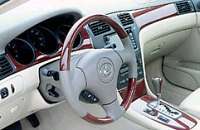 Perhaps the new
exterior styling can score back some points ? unlike its predecessor, it
was styled in Japan instead of California, but it has an aircraft-style
profile and radical nose to make you believe it was done in the USA.
However, the organic grilles and headlights are unlikely to withstand the
test of time, and they devoid of any sense of prestige. The last ES300
feels more expensive. Perhaps the new
exterior styling can score back some points ? unlike its predecessor, it
was styled in Japan instead of California, but it has an aircraft-style
profile and radical nose to make you believe it was done in the USA.
However, the organic grilles and headlights are unlikely to withstand the
test of time, and they devoid of any sense of prestige. The last ES300
feels more expensive.
Inside is
much better. There is more space than its RWD or 4WD rivals. Light-color
soft leather contributes to a warm-feeling environment. Instruments are
clear and economical, but the plastics used is not
first-class.
Among
Lexus' line-up, this one is the most non-Lexus. It does not feel as
prestige as LS, nor as exciting to drive as IS and GS. After all, it is
still a pseudo prestige car built on Camry. Small investment doesn't worth
good sales.
Toyota Avalon / Pronard
 Avalon (or Pronard
for Japan) is built in the Kentucky plant alongside Camry on which it is
based. Basically, it is a grown-up Camry with massive increment of cabin
space enable it to be classified as full-size sedan by EPA regulations. In
other words, it targets Big 3’s products (especially the sales-topping
Buick LeSabre) instead of other Japanese cars. Avalon (or Pronard
for Japan) is built in the Kentucky plant alongside Camry on which it is
based. Basically, it is a grown-up Camry with massive increment of cabin
space enable it to be classified as full-size sedan by EPA regulations. In
other words, it targets Big 3’s products (especially the sales-topping
Buick LeSabre) instead of other Japanese cars.
Avalon offers 5 or 6 seats
configurations. In 6-seater form, front bench seat is used to accommodate
3 persons, and column shifter is used instead of conventional console
shifter. Undoubtedly, there are a lot of space for all occupants, because
the wheelbase is stretched by 50 mm from Camry, while width is up 35 mm,
height grows 40 mm. However, unlike its American opponents, Avalon is
"just" 4.9 meters long, thus its roominess is implemented by efficient use
of space rather than adding sheet metal.
 Carrying more weight than the Camry, it
requires more power. Toyota gave it Lexus ES300’s V6 (that is, Camry’s V6
plus VVT-i). 210 horsepower and 210 lbft of torque. 4-speed automatic is
smooth, although column shifter is tricky to select the correct
gear. Carrying more weight than the Camry, it
requires more power. Toyota gave it Lexus ES300’s V6 (that is, Camry’s V6
plus VVT-i). 210 horsepower and 210 lbft of torque. 4-speed automatic is
smooth, although column shifter is tricky to select the correct
gear.
Like other full-size sedans,
the suspension setting is very soft, hence there is apparent body roll in
tight corner. Even so, the Avalon is still better to handle than its
rivals.
Toyota Camry Solara
 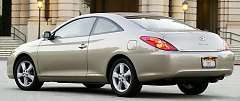
Solara is
the coupe version of Camry. Being built exclusively in Kentucky of USA
alongside the Camry, it differs from the sedan by just packaging and
tuning. It was styled by Toyota's California studio, hence looking sexier
than the Japanese-designed Camry. Nevertheless, there is strong traces of
Pininfarina's Alfa GTV in its side profile, harming its originality.
Besides, the sedan proportion (long wheelbase, long tail) doesn't do it
justice. It should have been more sporty, but sadly, Toyota would rather
save money and time by building it directly on the Camry
floorpan.
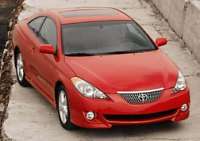 So, what you can expect from the Solara
is spacious cabin, good build quality and remarkable comfort, just like
the Carmy. It is powered by a new 3.3-litre V6 from Lexus RX330. 225
horsepower might be a little underpowered by today's standard, but it
remains smooth and quiet in Toyota's tradition. Because this is a
comfort-biased coupe, the V6 can partner with only a 5-speed automatic
from the sedan, although ratios have been tightened to improve
acceleration. It can therefore go from rest to 60mph in a brisk 7.0
seconds. A drag coefficient of 0.29 also allows it to slip easily into air
stream. So, what you can expect from the Solara
is spacious cabin, good build quality and remarkable comfort, just like
the Carmy. It is powered by a new 3.3-litre V6 from Lexus RX330. 225
horsepower might be a little underpowered by today's standard, but it
remains smooth and quiet in Toyota's tradition. Because this is a
comfort-biased coupe, the V6 can partner with only a 5-speed automatic
from the sedan, although ratios have been tightened to improve
acceleration. It can therefore go from rest to 60mph in a brisk 7.0
seconds. A drag coefficient of 0.29 also allows it to slip easily into air
stream.
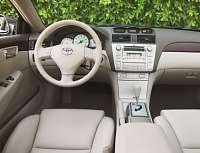 Enter the cabin, after disappointed
with the sedan-like dashboard design, you will start appreciating the good
materials and fit and finish as well as vast of space. Only taller
passengers at the back will find their heads toughing the fastback roof.
Sound insulation is almost as effective as the
sedan. Enter the cabin, after disappointed
with the sedan-like dashboard design, you will start appreciating the good
materials and fit and finish as well as vast of space. Only taller
passengers at the back will find their heads toughing the fastback roof.
Sound insulation is almost as effective as the
sedan.
Now fun time.... maybe not so
fun. Although Toyota claimed to inject more sporting character into the
new Solara than the last generation, the scale of improvement is actually
too small. It does have stiffer suspension setup than the sedan. It does
employ a tower brace over the front suspension to stiffen the chassis. It
does have better sorted damping than the last generation. However, compare
with European coupes it still cares too much about female buyers. With
relatively soft suspension setup and a bulky size, the Solara fails to
control roll and pitch as good as European coupes. This also leads to
severe understeer at tight corners. Furthermore, the steering is too light
and too numb to give you any confidence. Some German cars are more capable
than inspiring. This Toyota is neither capable nor inspiring. It is just a
sedan in a coupe's clothes.
|
Model |
Camry 2.4 |
Camry V6 |
Lexus ES300 |
|
Layout |
Front-engined,
Fwd |
Front-engined,
Fwd |
Front-engined,
Fwd |
|
L / W / H / WB
(mm) |
4805 / 1795 / 1490 /
2720 |
4805 / 1795 / 1490 /
2720 |
4854 / 1811 / 1455 /
2720 |
|
Engine |
Inline-4, dohc, 4v/cyl,
VVT,
bal
shaft. |
V6, dohc,
4v/cyl,
var
intake. |
V6, dohc, 4v/cyl,
VVT. |
|
Capacity |
2362
cc |
2995
cc |
2995
cc |
|
Power |
157
hp |
192
hp |
210
hp |
|
Torque |
163
lbft |
209
lbft |
220
lbft |
|
Transmission |
5M |
4A |
5A |
|
Suspension
(F/R) |
All:
strut |
All:
strut |
All:
strut |
|
Tyres
(F/R) |
All: 205/60
R16 |
All: 215/60
VR16 |
All: 215/60
VR16 |
|
Weight |
1435
kg |
1545
kg |
1560
kg |
|
Top
speed |
N/A |
N/A |
N/A |
|
0-60
mph |
N/A |
8.4
sec* |
8.3 sec
(est) |
|
0-100
mph |
N/A |
23.7
sec* |
N/A |
|
Model |
Avalon 3.0 |
Solara 3.0 |
- |
|
Layout |
Front-engined,
Fwd |
Front-engined,
Fwd |
- |
|
L / W / H / WB
(mm) |
4895 / 1820 / 1460 /
2720 |
4892 / 1815 / 1425 /
2720 |
- |
|
Engine |
V6, dohc,
4v/cyl. |
V6, dohc,
4v/cyl. |
- |
|
Capacity |
2995
cc |
3311
cc |
- |
|
Power |
194
hp |
225
hp |
- |
|
Torque |
209
lbft |
240
lbft |
- |
|
Transmission |
4A |
5A |
- |
|
Suspension
(F/R) |
All:
strut |
All:
strut |
- |
|
Tyres
(F/R) |
All: 205/60
R16 |
N/A |
- |
|
Weight |
1475
kg |
1585
kg |
- |
|
Top
speed |
N/A |
N/A |
- |
|
0-60
mph |
8.4
sec* |
6.9
sec** |
- |
|
0-100
mph |
N/A |
19.4
sec** |
- |
TOYOTA MARK II
Related models : Verossa, Progres, Brevis - shares major components and floorpan
 This is the
Japanese interpretation of "sports sedan" - a twin-turbo 2.5-litre
straight six pumps out 280 horsepower, providing acceleration eclipsing
many sports cars. The chassis is not very stiff by today's standard, but
compensate that by riding on stiff springs results in good roll-control in
corner. The steering is surprisingly heavy by Japanese standard, but apart
from kickback it offers no feel. Though the car is rear-drive and have
perfect double-wishbones suspensions all round, it understeers rather
early and spoil any enthusiasm to attack corner. When you call for driving
fun, it says to you, "I'm a luxury sedan". Then you ask for a supple ride
and it replied, "I'm a sports car". In contrast, a BMW will satisfy both
requirements. Fly the Mark II on highway and you can sense the cross wind,
shake and roll due to aerodynamic lift. This is the
Japanese interpretation of "sports sedan" - a twin-turbo 2.5-litre
straight six pumps out 280 horsepower, providing acceleration eclipsing
many sports cars. The chassis is not very stiff by today's standard, but
compensate that by riding on stiff springs results in good roll-control in
corner. The steering is surprisingly heavy by Japanese standard, but apart
from kickback it offers no feel. Though the car is rear-drive and have
perfect double-wishbones suspensions all round, it understeers rather
early and spoil any enthusiasm to attack corner. When you call for driving
fun, it says to you, "I'm a luxury sedan". Then you ask for a supple ride
and it replied, "I'm a sports car". In contrast, a BMW will satisfy both
requirements. Fly the Mark II on highway and you can sense the cross wind,
shake and roll due to aerodynamic lift.
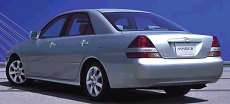 Admittedly, Toyota has been changing.
IS200 was made according to European taste and tuned in Nurburgring before
appearing in show room. But it is a copy cat. What the Mark II has is a
unique character - no matter you like it or not. It won't appeal to most
of us - otherwise Toyota won't bound its sales in Japan - but it is a
living history for Japanese traditional sports sedan. A history started in
1968 and entered the 9th generation last year. Its sister car Cresta has
already announced dead. Another sister Chaser is also dying. The same goes
for Nissan's similar Laurel. Everybody can see this kind of cars will
eventually die under the threat of European prestige
marques. Admittedly, Toyota has been changing.
IS200 was made according to European taste and tuned in Nurburgring before
appearing in show room. But it is a copy cat. What the Mark II has is a
unique character - no matter you like it or not. It won't appeal to most
of us - otherwise Toyota won't bound its sales in Japan - but it is a
living history for Japanese traditional sports sedan. A history started in
1968 and entered the 9th generation last year. Its sister car Cresta has
already announced dead. Another sister Chaser is also dying. The same goes
for Nissan's similar Laurel. Everybody can see this kind of cars will
eventually die under the threat of European prestige
marques.
TOYOTA VEROSSA
 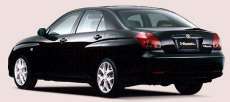 T he days left for traditional Japanese-taste luxury cars are
limited. Toyota no longer needs Chaser and Cresta as supporting roles to
Mark II, therefore both were replaced by a European-style new comer,
Verossa. From the name which consists of Italian words "Vero" (True) and
"Rossa" (Red) you’ll see this car tends to attract younger customers who
used to prefer the dynamic image of BMW 3-series and Audi A4. In fact, the
radical styling has strong Latin influence. Not unlike Alfa Romeo, but
even more exaggerate, something approaching Zagato. Officially it is said
as designed in Japan, but who knows whether Zagato gave any inspiration ?
you know, Toyota is the biggest client of Zagato.
Mechanically, Verossa is a
repackaged Mark II as they share virtually the same dimensions and all
mechanical components. However, Progres and Brevis are also its sisters,
just have shorter overhangs and different choice of engines from the same
gene pool. To lesser extent, all of them can also link to the smaller
Altezza (Lexus IS). Strangely, all these cars bar Altezza are bounded in
domestic market thus cannot avoid internal
competition.
What differs the Verossa from
Mark II is not performance or comfort. It is the subjective dynamic image
delivered by the styling. So, I have no more say about
it.
|
Model |
Mark
II 2.5 turbo |
Verossa 2.5 |
|
Layout |
Front-engined,
Rwd |
Front-engined,
Rwd |
|
Size (L / W / H / WB)
mm |
4735 / 1760 / 1460 /
2780 |
4705 / 1760 / 1450 /
2780 |
|
Engine |
Inline-6, dohc,
4v/cyl,
VVT,
turbo |
Inline-6, dohc,
4v/cyl,
VVT,
direct-injeciton |
|
Capacity |
2491
c.c. |
2491
c.c. |
|
Power |
280
hp |
200
hp |
|
Torque |
278
lbft |
184
lbft |
|
Transmission |
4A |
5A |
|
Suspensions |
All: double
wishbones |
|
Tyres |
225/45
R17 |
N/A |
|
Weight |
1530
kg |
1490
kg |
|
Top
speed |
N/A |
N/A |
|
0-60
mph |
N/A |
N/A |
|
0-100
mph |
N/A |
N/A |
TOYOTA CROWN
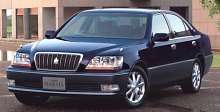 Appeared in 1955,
"Crown" is the oldest nameplate in Toyota’s current line-up. Generation
after generation, today’s Crown is still the most popular company car in
Japan, which is good, but its presence is still bounded in domestic market
and South East Asia, which is less good. One word summarise its character
- Conservative. To please Japanese company executives and businessmen, you
know, it HAS to be conservative in styling and trimming. It has to ride as
supple as magic carpet, offering independent audio, climate and lighting
controls for the rear passenger. In contrast, driving pleasure is not very
important. Appeared in 1955,
"Crown" is the oldest nameplate in Toyota’s current line-up. Generation
after generation, today’s Crown is still the most popular company car in
Japan, which is good, but its presence is still bounded in domestic market
and South East Asia, which is less good. One word summarise its character
- Conservative. To please Japanese company executives and businessmen, you
know, it HAS to be conservative in styling and trimming. It has to ride as
supple as magic carpet, offering independent audio, climate and lighting
controls for the rear passenger. In contrast, driving pleasure is not very
important.
But the latest Crown is no
longer that conservative. It has been styled, tuned and trimmed to please
driver as well as passenger. To be honest, it is still not as driver-bias
as Lexus GS, but the improvement made is substantial enough to let you
forget any pervious Crowns. For the first time, I found the Crown looks
quite nice. Nice, if not handsome. Doesn’t it look like a Lexus
LS400?
 The cabin also looks fresh. Lexus-like
back-lit gauges looks cool. Center console has a unique shape and is no
longer taxi-like. Two-tone colours match very well with wood decoration
and leather trimming, although I suspect the wood is fake. Fit and finish
is first rate, so is the quality of material. My only complain is the
dull-looking 4-spoke steering wheel. There’s plenty of space for front and
rear passengers, the latter also enjoy independent audio and climate
control, reading lamps and a small refrigerator behind the arm rest.
Overall speaking, it’s an enjoyable place to spend hours of long
journey. The cabin also looks fresh. Lexus-like
back-lit gauges looks cool. Center console has a unique shape and is no
longer taxi-like. Two-tone colours match very well with wood decoration
and leather trimming, although I suspect the wood is fake. Fit and finish
is first rate, so is the quality of material. My only complain is the
dull-looking 4-spoke steering wheel. There’s plenty of space for front and
rear passengers, the latter also enjoy independent audio and climate
control, reading lamps and a small refrigerator behind the arm rest.
Overall speaking, it’s an enjoyable place to spend hours of long
journey.
There are 3 versions of Crown
- Majesta, Royal and Athlete. The Athlete is the most sporty, with
stiffest suspension setup. Majesta is most luxurious, powered by a 280 hp
V8. It also has longer wheelbase. Royal runs middle of the road and is
usually the best seller among them. No matter which version, handling is
far beyond imagination. Gone is the traditional soft suspension setup,
which is replaced with firmer springing and damping. As a result, steering
response and body control are greatly improved. Although it is still
regarded as comfort-bias by European standard, it is already more
driver-bias than other domestic rivals, including Nissan Gloria. In
particular, it rolls less and steer with more feel than the
Nissan.
 Although the range-topping Majesta is
powered by Lexus’s 4-litre V8, most other Crowns are likely to be ordered
with 3.0 inline-6. This 24-valver is actually the same as Supra and Lexus
GS300. No matter with or without direct-injection, it output 220
horsepower and 217 lbft of torque. As in Lexus GS, it is silky smooth and
quiet. Predictably, Toyota provides no option for manual gearbox, but
there are two electronic automatic for choose: 4-speed automatic is
smoother; 5-speed Super ECT (with Tiptronic style manual override mode) is
quicker. Although the range-topping Majesta is
powered by Lexus’s 4-litre V8, most other Crowns are likely to be ordered
with 3.0 inline-6. This 24-valver is actually the same as Supra and Lexus
GS300. No matter with or without direct-injection, it output 220
horsepower and 217 lbft of torque. As in Lexus GS, it is silky smooth and
quiet. Predictably, Toyota provides no option for manual gearbox, but
there are two electronic automatic for choose: 4-speed automatic is
smoother; 5-speed Super ECT (with Tiptronic style manual override mode) is
quicker.
|
Model |
Crown
Athlete 3.0G |
Crown Majesta V8 |
|
Layout |
Front-engined,
Fwd |
Front-engined,
Fwd. |
|
Dimensions |
L / W / H /
WB:
4820 / 1765 / 1455 / 2780
mm |
L / W / H /
WB:
4900 / 1795 / 1465 / 2800
mm |
|
Engine |
Inline-6, dohc,
4v/cyl,
VVT,
direct-injection |
V8, dohc, 4v/cyl,
VVT |
|
Capacity |
2997
c.c. |
3968
c.c. |
|
Power |
220
hp |
280
hp |
|
Torque |
217
lbft |
296
lbft |
|
Transmission |
5A with manual
mode |
5A with manual
mode |
|
Suspension |
All: double
wishbones |
|
Tyres |
215/55
R16 |
N/A |
|
Weight |
1580
kg |
1700
kg |
|
Top
speed |
N/A |
N/A |
|
0-60
mph |
N/A |
N/A |
|
0-100
mph |
N/A |
N/A |
TOYOTA CENTURY
Century is the local-bounded model which
topped the company's model range. Since 1967, it did not received any
significant modification until recently. The 1997 version boosted by a
larger body and an amazing 5 litres V12 (Japan's first V12) with 48 valves
and variable valve timing. Like other powerful Japanese engines, it is
voluntarily bounded to 280hp, but accompany with astonishing 355lbft of
torque. Without doubt, its suspensions are tuned to be very soft while the
driver appeal is..... those Japanese enterprise directors won't drive the
Century by themselves !
 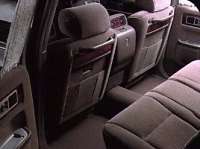
|
Model |
Century |
|
Layout |
Front-engined,
Rwd |
|
Dimensions |
N/A |
|
Engine |
V12, dohc, 4v/cyl,
VVT. |
|
Capacity |
4996
c.c. |
|
Power |
280
hp |
|
Torque |
355
lbft |
|
Transmission |
4A |
|
Suspensions |
N/A |
|
Tyres |
N/A |
|
Weight |
N/A |
|
Top
speed |
N/A |
|
0-60
mph |
N/A |
|
0-100
mph |
N/A |
Toyota Altezza / Lexus IS200
Related models: Progres, Brevis
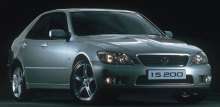 BMW 02 Series and
3 Series are one of the miracles in motor history. They proved there are
millions of keen drivers that would pay premium price and sacrifice a
little bit passenger comfort for a sedan with superb handling and
performance. For thirty years, BMW dominated this market segment without
any serious challenge. As the market is expanding, Audi A4 and Alfa Romeo
entered the market, both with great success. Toyota, which has already
created the 5-Series-challenging GS400, also wants to have a slice in this
market. BMW 02 Series and
3 Series are one of the miracles in motor history. They proved there are
millions of keen drivers that would pay premium price and sacrifice a
little bit passenger comfort for a sedan with superb handling and
performance. For thirty years, BMW dominated this market segment without
any serious challenge. As the market is expanding, Audi A4 and Alfa Romeo
entered the market, both with great success. Toyota, which has already
created the 5-Series-challenging GS400, also wants to have a slice in this
market.
If you are European or
American, you need to do 100% to win people's heart. If you are Asian, you
need to achieve 120% of what the European done in order to win their
respect. That's what Toyota's engineers thought. Therefore, from the
beginning they chose the most ideal mechanical configuration for their
3-Series challenger : rear-wheel-drive and all double wishbones
suspensions.
They know their suspension
tuning used to be criticized by the Western media as too soft, steering
used to be criticized as too light and lifeless, so they spent extra time
to test and tune the car in Germany. After that, they decided to equip the
car with sports car-style 17 inches wheels with 45% aspect ratio, a first
in this class of car. Besides, 6 speed manual and 5 speed adaptive
automatic were employed for enhancing driving
pleasure.
In terms of engine, they
thought they have nothing to worry about. From the existing range, they
picked up Celica and MR2's 2-litres four, upgraded with double VVT-i (at
both inlet and exhaust valves) and titanium valves. Accompany with 11.5 :
1 high compression ratio, this high-revving unit output 210ps at 7600rpm
and 160lbft at 6400rpm.
So, this becomes the Altezza,
the Japanese Car of the Year 1999. According to the local magazines which
have tested it, Altezza has the handling to overshadow the latest BMW
3-Series E46. Steering is neutral and sensitive, body control and grip are
extremely good.
Supra has good handling and
performance, but it was criticized as lack of character. Altezza avoid
this by deliberately making a beautiful exhaust note.
However, comparing with BMW
323i, 328i and Alfa 156 V6, Altezza's inline-4 feels lack of power. Forget
the 210ps rating, the lack of capacity result in the lack of torque and a
relatively peaky torque curve. Road testers felt unable to exploit the
potential of the chassis.
Altezza / IS200 is rather
small compare with the 3-Series. It is 71mm shorter, 19mm narrower and 5mm
lower. Wheelbase is 55mm shorter. Although the rectangular shape seems to
benefit interior room, it isn't. 6 feet high rear passengers will find
their heads touching the roof as in the 3 Series. However, rear leg room
is marginally better.
Toyota's stylists
intentionally create a very aggressive interior. Undoubtedly, the
highlight is 4-in-one chronograhic dial, which is probably inspired by
Casio's G-shock watch. What a pity the packaging is awful. You'll see
cheaper grade of plastic than rivals and sub-standard build quality for a
Lexus. The seats looks unattractive and feels not very comfortable, mostly
because of lacking lumbar adjustment and short in the squab. Steering
wheel is not adjustable in reach thus deteriorate the otherwise good
driving position.
The exterior looks even worse.
This is the ugliest car I have seen in the whole 1998. Although recently I
see this car twice a day averagely, I still can't accept its
look.
Lexus
IS200A cheaper
version was developed for both domestic and overseas market. For overseas
market, it is badged as Lexus IS200. It is powered by a 2-litre straight 6
modified from the Mark II sedan, with inlet-bounded VVT-i. Lower
compression ratio (10.0:1) suits the inferior fuel in overseas. Its output
is very much lower : 153hp, although the 144lbft / 4400rpm makes
acceleration less different.
It is not provided with the 5
speed automatic. People who need auto have to put up with the slow 4A.
However, IS200 has a flat undertray to improve the coefficient of drag
from 0.29 to 0.28. It should benefit high speed cruising on Germany's
autobahn.
Road test
impression
2 UK publications tested the
IS200 and reported great impression. Both describe it handles very good on
smooth surface. Steering feels very communicative in action, quick and
more accurate than 3-Series. Nevertheless, power steering offers an
abundance of assistance during parking. The chassis and well tuned
suspensions feels alive in bends, body control precisely and tightly
thanks to the grippy 215 tyres. However, when arriving limit, steering
feel fade out as the camber change (due to body roll) makes the thin, 45%
aspect ratio tyres riding on their outside edge. In this respect, BMW 3
Series and Alfa 156 deal better with cornering limit.
In terms of ride, Lexus IS200
is a little bit bias towards hard for some people but just perfect for
keen drivers. Even our civilised local magazines regard its ride comfort
as acceptable.
As predicted, performance is
the weakest sector of the baby Lexus, at least until the arrival of IS300.
Against the clock, it took a full 9 seconds to complete 0-60mph. 0-100mph
of 25.8sec is no better. Not just the figures prove that, in fact the
driver always feel the engine lack of flexibility and punch to keep up
with BMW 323i (0-60 in 7.6sec) and even Alfa 156 2.0TS (8.1sec). It just
edge out the four cylinder 318i.
Luckily, the short-throw,
close-ratio 6-speed manual gearbox keeps the driver involving. The lovely
exhaust noise also enhance excitement.
On a typical rough B-road,
IS200 started to show its shortness in damping and body control, also
shows some high speed float. Steering feel deteriorates as speed
increases. Now I know why the European IS200 has added with the flat
undertray : because the engineers experienced high speed stability problem
during its test in Germany. They thought they've solved the problem by the
addition of flat bottom thus the reduction of lift, but on rough British
roads it is another matter.
Lexus IS300
The so-called 3-series segment is getting
excited now. Lexus has already shipped IS300 to the USA. Unlike the IS200,
it should have abundance of power to beat the benchmark BMW 328i. That’s a
total of 215 horsepower and 218 lbft of torque, coming from the
Supra-derived 24-valve straight six displacing 2997 c.c., aided with VVT-i
continuously variable valve timing. It’s virtually the same as GS300 and
Crown’s power plants too.
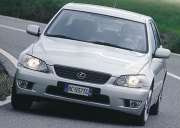 Don’t celebrate too early. BMW is
introducing a 3.0-litre straight six into the 3-series as well. This
engine will replace the 2.8 unit in all BMW models. It retains the basic
construction of the current 2.5 and 2.8 unit, that means all aluminium
construction and Double Vanos VVT. The extra displacement boost power and
torque to 231 hp (DIN) and 221 lbft (DIN) respectively. In SAE scale, it
is 225 hp and 214 lbft. So the new 330i will be at least as quick as the
IS300. Don’t celebrate too early. BMW is
introducing a 3.0-litre straight six into the 3-series as well. This
engine will replace the 2.8 unit in all BMW models. It retains the basic
construction of the current 2.5 and 2.8 unit, that means all aluminium
construction and Double Vanos VVT. The extra displacement boost power and
torque to 231 hp (DIN) and 221 lbft (DIN) respectively. In SAE scale, it
is 225 hp and 214 lbft. So the new 330i will be at least as quick as the
IS300.
In terms of eagerness, sound
quality or refinement, unless the new BMW 3.0 is worse than the 2.8 (very
unlikely), it won’t have problem to beat the Lexus counterpart. In fact,
BMW’s 2.5 and 2.8 have been one of the Ward’s 10 best engines since their
debut, while Lexus’s straight six never won this title. The differences
are small, but enough to distinguish.
The IS200 was already praised
as a good driver’s car, better than any Japanese sedan ever achieved.
However, giving the bigger engine burdening the nose, handling is
inevitably compromised a bit. Although Lexus claimed the center of engine
is located 55 mm behind the front axle, this also implies that nearly half
of the engine is hanging in front of the axle. Most important, unlike BMW,
it has heavy cast iron block. Toyota has yet to develop an all-alloy
in-line six.
According to early road test
impression, extra weight at the front results in poorer handling. At
modest drive, it behaves as sporty and communicative as the IS200. Under
pressure, the IS300 has quite a lot of understeer.
Steering feel is
deteriorated. Damping on rough roads isn’t as good too.
In contrast, the marvellous
3-series never has such problems. Basically, there is no difference in
handling can be felt among 318i, 323i and 328i. What separate them is just
the wheel and tyre, which give the pricier models a positive edge.
Therefore we can predict the 330i will handle better than
IS300.
Lexus loses another battle in
the drive train. Unlike BMW, it doesn’t offer a manual transmission for
the IS300, at least for the first year. It’s a big disappointment, as the
IS200’s 6-speed manual shift so sweet. There’s rumours saying the IS200’s
unit cannot handle the extra torque from the new engine. So far, the most
demanding application of that gearbox is used in Nissan Silvia turbo,
which handles 203 lbft of torque, still not matching the IS300’s 218 lbft.
Another feasible gearbox is Supra’s 6-speeder, which always mate to this
2JZ-GE engine. However, a Japanese tuner has already proved that it
doesn’t fit neatly into the Altezza (that is, Japanese IS200). It requires
the shifter lever to be relocated several centimetres rearward. Moreover,
it doesn’t shift as slick as the IS200’s.
Toyota is now trying to fix
that, so in the first year only a 5-speed automatic will be offered. It is
already optional in Altezza and standard in GS400, with E-shift manual
override via the buttons on the spokes of steering wheel. Nice auto, but
it’s hard to convince that a driver’s car shift by itself. Performance is
also harmed - Lexus claimed a top speed of 143 mph and 0-60 mph in 7.1
seconds, no match with BMW’s claim for the 330i, that is, 155 mph and 0-62
in 6.5 sec.
Weight also plays an important
role in performance. At 1483 kg, the IS300 has lost any advantage over
BMW.
Oddly, American Lexus offer
205/55R16 tyres as standard for the most powerful IS, with 215/45ZR17 as
option. European IS300 will offer the 17-in as standard, just like the
IS200.
As usual, there is price
advantage for the Lexus. I expect 5-10% over the BMW 330i with equivalent
equipment. That doesn’t mean Toyota can make the IS cheaper, it is just
BMW can enjoy higher profit margin because it is still the
benchmark.
Toyota Progres
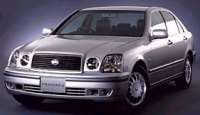 Progres could be
said as the forerunner of Altezza. It was launched half a year earlier
than the latter, but unlike its sister, sales is bounded in Japan. While
the Altezza represents a new idea, the Progres conforms to the traditional
value. Although based on the same rear-wheel-drive platform, its wheelbase
has an extra 110mm to provide the amount of cabin space that a luxurious
sedan deserve. Similarly, the overall length is 100mm longer than Altezza,
while the 1700mm width is 20mm short of its sister, once again prove that
it is not designed for ultimate driving excitement. Progres could be
said as the forerunner of Altezza. It was launched half a year earlier
than the latter, but unlike its sister, sales is bounded in Japan. While
the Altezza represents a new idea, the Progres conforms to the traditional
value. Although based on the same rear-wheel-drive platform, its wheelbase
has an extra 110mm to provide the amount of cabin space that a luxurious
sedan deserve. Similarly, the overall length is 100mm longer than Altezza,
while the 1700mm width is 20mm short of its sister, once again prove that
it is not designed for ultimate driving excitement.
Engines come from Mk II and
Supra etc., model NC250 gets a 2.5 litres VVT-i straight six, rated at
200ps and 185lbft. NC300 is powered by Supra's 3.0 litres VVT-i straight
six, capable of 215hp and 217lbft. Rumour said the 2.5 unit may eventually
share with IS200 in order to compete with BMW 323i.
Toyota Brevis
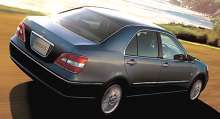 Toyota Brevis is
the twins sister of Progres, hence an enlarged Lexus IS. Unlike Progres,
the new Brevis aims at younger customers and compete directly with imports
like BMW 3-series and Mercedes C-class. Basically, the chassis and
powertrains are identical to Progres. What makes it more appealing is a
(relatively) handsome exterior styling and a beautifully trimmed interior.
The stylish center console houses a LCD monitor and an alloy-effect sound
system consists of on-dash CD changer, DVD and MD, with 7 speakers on top
model. Besides, like Ford Taurus, it provides power pedals which can
adjust across a range of 70mm to suit drivers of different height. Better
than Taurus, the position of pedal, steering wheel and driver’s seat are
memorised. Toyota Brevis is
the twins sister of Progres, hence an enlarged Lexus IS. Unlike Progres,
the new Brevis aims at younger customers and compete directly with imports
like BMW 3-series and Mercedes C-class. Basically, the chassis and
powertrains are identical to Progres. What makes it more appealing is a
(relatively) handsome exterior styling and a beautifully trimmed interior.
The stylish center console houses a LCD monitor and an alloy-effect sound
system consists of on-dash CD changer, DVD and MD, with 7 speakers on top
model. Besides, like Ford Taurus, it provides power pedals which can
adjust across a range of 70mm to suit drivers of different height. Better
than Taurus, the position of pedal, steering wheel and driver’s seat are
memorised.
Brevis rides on the same
rear-drive platform as Lexus IS, with wheelbase extended to 2780 mm to
better all its European rivals. In terms of size and weight, it stand
between a BMW 3-series and 5-series, so cabin space is plenty. However,
dynamically speaking it can hardly match the European rivals (that role is
left for Lexus to fulfill), although rides on double-wishbones
suspensions. Suspension is set softer than the Lexus, steering is less
direct, and its 1550 kg kerb weight also hurt handling
agility.
There are two choices of power
plant: 2.5-litre or 3.0-litre straight-six, pumping out 200 hp and 220 hp
respectively. Both are equipped with VVT-i and D-4 direct injection. In
contrast, there is only 1 transmission available - 5-speed ECT automatic
without Tiptronic-style manual override, the same one as
IS300.
Of course, Brevis is bounded
in domestic market.
|
Model |
Lexus
IS200 |
Toyota
Altezza RS200 |
Lexus IS300 |
|
Layout |
Front-engined,
Rwd |
Front-engined,
Rwd |
Front-engined,
Rwd |
|
Dimensions |
L / W / H / WB: 4400 /
1720 / 1410 / 2670 mm |
|
Engine |
Inline-6, dohc, 4v/cyl,
VVT |
Inline-4, dohc, 4v/cyl,
VVT. |
Inline-6, dohc, 4v/cyl,
VVT |
|
Capacity |
1988
c.c. |
1998
c.c. |
2997
c.c. |
|
Power |
153 hp
(DIN) |
210 ps
(JIS) |
215 hp
(SAE) |
|
Torque |
144 lbft
(DIN) |
160 lbft
(JIS) |
218 lbft
(SAE) |
|
Transmission |
6M |
6M |
5A with manual
mode |
|
Suspension |
All: double
wishbones |
|
Tyres |
215/45
ZR17 |
215/45
ZR17 |
215/45 ZR17
(option) |
|
Weight |
1435
kg |
1360
kg |
1483
kg |
|
Top
speed |
137
mph* |
143 mph
(estimated) |
143 mph
(claimed) |
|
0-60
mph |
9.0
sec* |
7.7 sec
(estimated) |
7.5
sec** |
|
0-100
mph |
25.8
sec* |
N/A |
19.5
sec** |
Toyota Aristo / Lexus GS
 BMW 5-series, the untouchable. Since 1996, the 5-series has been
the benchmark of the class, offering driver appeal as well as refinement
that competitors hardly match. Among many challengers, Toyota Aristo comes
closest to the benchmark. BMW 5-series, the untouchable. Since 1996, the 5-series has been
the benchmark of the class, offering driver appeal as well as refinement
that competitors hardly match. Among many challengers, Toyota Aristo comes
closest to the benchmark.
Aristo is better known as
Lexus GS300 / 430 for overseas market. You might remember, the first
generation Aristo / GS had a sporty styling penned by Italdesign but it
didn’t drove like that. In contrast, the new car looks less pretty, a bit
too fat, and the irregular-shaped headlights seem odd, but underneath the
skin is a competent chassis and powertrain combination. As usual, Toyota
gave it the best components - double wishbones suspension all round,
rear-wheel drive, front and rear subframes - but most crucial is the
chassis setup, which distinguish the new GS from its predecessor or Crown.
However, let us first start from the heart ...
Having experience about Supra,
you don’t need more description about GS300’s engine. In fact, Toyota uses
this 2997 c.c. straight six (with dohc, 24 valves and VVT-i variable valve
timing) throughout all its rear-drive big cars, such as Mark II, Crown and
Supra. Powerful, responsive and smooth are its basic instinct, letting it
to rival BMW’s 2.8 well. If you want more power, Aristo provides two
additional turbochargers and boost output to the domestic boundary of 280
hp, with 334 lbft to match. In other words, that’s the same heart of Supra
turbo. However, best among them is GS430’s 4.3-litre V8, also aided by
VVT-i. It pumps out 300 silky smooth horsepower without any hesitation.
More powerful than BMW’s 4.4 V8, yet refiner. Perfect.
Working in companion with the
fine engines is a 5-speed adaptive automatic. For GS430, it offers E-shift
Tiptronic-style manual override with finger-operated button on steering
wheel spokes.
The V8 gives GS430
fire-breathing performance: it takes just 6.0 seconds for 0-60 mph
acceleration. Top speed is electronically limited to 155 mph like its
German rivals. In contrast, GS300 is just average by class standard.
Autocar magazine found it took 8.5 sec for 0-60 and the kerb weight is 140
kg in excess of a BMW 528i. Admittedly, the GS300 paid little attention to
weight saving - the straight six still uses cast iron block (the V8 is
aluminium alloy). There’s no aluminium used in suspension as well, unlike
BMW and Audi.
Lack of aluminium suspension
also distinguish its ride quality from the BMW benchmark. Generally
speaking, Lexus GS is tuned softer than its German rivals. Even with the
UK-only Sport suspension package (with 17-inch wheels), although it runs
very close to the 5-series, it is still noticeable the BMW has an edge in
body control, steering feel and ride quality. The low-profile tyres ride
and damp pretty well at speed, but does not overcome low speed bump as
good as 5-series. 17-inch wheels are also optional for the GS430, although
the suspension is no stiffer than the standard setup. American journalists
also agreed the BMW 540i handles and rides better. In particular, the
standard suspension lead to more roll and pitch, without the confidence
experienced in BMW and Audi. European version GS430 fitted with Sport
suspension package has quite poor ride on bumpy road, which is hardly
forgivable for a Lexus, while body control and steering are both worse
than GS300, thanks to the extra weight of V8.
That said, the GS is less
sportier than 5-series and A6 (V8 only), but its driver appeal as well as
refinement are well ahead of any front-drive A6, Jaguar S-Type and Lincoln
LS. What about Mercedes E-class? it’s good, but too expensive to be direct
competitors. Talking about price, the GS300 isn't cheap in Euorpe,
therefore Lexus found it difficult to shift more than 3,000 cars there
annually.
While handling and ride
matches the German, interior trimming is not. There is purposeful styling
for dashboard, such as 3 separate backlit gauges. There are a lot of
equipment as well, plus full leather trim. The problem is lack of classy
feeling. The plastic feels cheap. The placement and styling of ventilation
lack of attention to detail. Fit and finish is also under question. It
feels more American than European, not even matching Lexus’ own SC
coupe.
However, the GS is still a
satisfying executive sedan offering remarkable refinement, comfort and
European-style handling. GS400 is especially good for high speed
cross-country journey. It’s fast and relaxing.
|
Model |
Lexus
GS300 |
Lexus
GS430 |
Toyota
Aristo |
|
Layout |
Front-engined,
Rwd |
Front-engined,
Rwd |
Front-engined,
Rwd. |
|
Dimensions |
L / W / H / WB: 4805 /
1800 / 1435 / 2800 mm |
|
Engine |
Inline-6, dohc, 4v/cyl,
VVT |
V8, dohc, 4v/cyl,
VVT. |
Inline-6, dohc,
4v/cyl,
VVT,
twin-turbo. |
|
Capacity |
2997
c.c. |
4293
c.c. |
2997
c.c. |
|
Power |
218
hp |
300 hp
(SAE) |
280 hp
(JIS) |
|
Torque |
219
lbft |
325 lbft
(SAE) |
334 lbft
(JIS) |
|
Transmission |
5A |
5A |
5A with manual
mode |
|
Suspensions |
All: double
wishbones |
|
Tyres |
N/A |
235/45ZR17 |
N/A |
|
Weight |
1671
kg |
1745
kg |
1680
kg |
|
Top
speed |
140
mph* |
155 mph
(limited) |
155 mph
(limited) |
|
0-60
mph |
8.5
sec* |
5.9
sec* |
N/A |
|
0-100
mph |
23.6
sec* |
14.8
sec* |
N/A |
Lexus LS430
Related models: Celsior - Japanese version badged as Toyota.
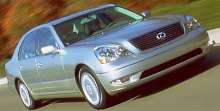 One of the most successful Japanese cars in history is Lexus LS400.
When it was launched in 1989, many Western automotive industrial insiders
could not virtually believe what the first attempt from Japan had done:
very high quality, all-round refinement, ultra-smooth and near-silent V8,
comfortable ride ... plus a bargain price that scared Mercedes and
BMW. One of the most successful Japanese cars in history is Lexus LS400.
When it was launched in 1989, many Western automotive industrial insiders
could not virtually believe what the first attempt from Japan had done:
very high quality, all-round refinement, ultra-smooth and near-silent V8,
comfortable ride ... plus a bargain price that scared Mercedes and
BMW.
Luxurious car
market was originally dominated by Mercedes and BMW (plus a small portion
by Jaguar). Those German makers, especially Mercedes-Benz, has many years
of experience in making the best sedans in the world. Therefore when Lexus
LS400 overtook them in only one night, and then followed by Nissan's
alternative, Infiniti Q45, this market was significantly changed. First we
saw the more open-minded American buyers steered towards Japanese luxury
by their wisdom. As a result, LS400 beat Mercedes and BMW in number of
sales in the North America market, believe it or not
!
 However, because of
rising Yen and rising production cost in Japan, the price of LS400
gradually increased throughout the first half of the 90s; simultaneously,
Mercedes, BMW, Audi and Jaguar fought back with newer models. LS lost its
top spot in sales chart. The ’95 and ’97 makeover did stopped sales
decline temporarily, but only an all-new LS can put Lexus back in
limelight. However, because of
rising Yen and rising production cost in Japan, the price of LS400
gradually increased throughout the first half of the 90s; simultaneously,
Mercedes, BMW, Audi and Jaguar fought back with newer models. LS lost its
top spot in sales chart. The ’95 and ’97 makeover did stopped sales
decline temporarily, but only an all-new LS can put Lexus back in
limelight.
Finally,
Toyota showed the new Lexus LS430 in the Jan 2000, Detroit Motor Show.
That’s more than a decade after the original LS400
launched.
The LS430, indicated by its
name, has a bigger, 4.3-litre V8. The increase of displacement does not
provide more horsepower than the previous 290hp, but it boost more torque
- 320 lbft, or an increment of nearly 30 lbft, thus compensating the
slight weight increment. 0-60 mph in 6.7 seconds is by all means a very
quick luxurious sedan.
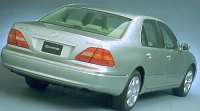 The exterior styling has a strong
resemblance to (not LS400, but) the previous generation Mercedes S-class,
once again demonstrating the incapability of Japanese designers. It’s not
a surprise, because its predecessor was already criticised as copying an
older S-class. Now we can predict how the next generation LS will look
like .... The exterior styling has a strong
resemblance to (not LS400, but) the previous generation Mercedes S-class,
once again demonstrating the incapability of Japanese designers. It’s not
a surprise, because its predecessor was already criticised as copying an
older S-class. Now we can predict how the next generation LS will look
like ....
The body is no longer or wider
but boost 55 mm height and 76 mm wheelbase. That guarantee a huge cabin
without increasing weight significantly. As Toyota sees aerodynamic as an
important mean to reduce wind noise, it smoothened the body to achieve a
class-leading drag coefficient of 0.25, which shares world record with
Honda Insight and Audi A2 "3-litre". At lower speed, the Cd is actually
0.26 because it rides on adaptive air suspension which lower ride height
at high speed. The system is believed to be taken from the Japanese
top-of-the-range Crown.
Once again, refinement is
untouchable. The S-class might ride as comfortable (also thanks to air
suspension) but the Lexus wins convincingly in quietness and smoothness.
The V8 remains almost silent at full throttle. Wind noise is obvious by
its absence. The 5-speed automatic box shifts so smooth. Its clever
program links with electronic throttle to deliver the smoothest gearshift
ever experienced - it cuts engine torque to smooth gear change; whenever
going uphill it increase torque to avoid downshift; whenever going down
hill or under braking it automatically downshift to take advantage of
"engine braking". 10 years on, European rivals still cannot match its high
level of refinement.
On the contrary, the LS430 has
narrowed the gap of dynamics. It has taken a big step forward from the
LS400. The steering is now reasonably communicative and is quite accurate.
The suspensions with stiffer springs, thicker anti-roll bar and new
dampers reduce body roll and contribute to sharper cornering. Therefore it
feels far more agile than before.
Ultimately there is still
something separate it from the likes of 7-series and S-class. The fact is,
the German duo still steer with a bit more sharpness and approach
cornering limit with more confidence. The Lexus, in contrast, display more
roll and understeer at limit. However, considering Lexus is designed to be
first priority in comfort, its dynamics is already remarkably
good.
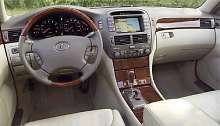 The new-found dimensions benefit a
roomy cabin which is equipped with many high-tech equipment just like the
new S-class, such as keyless entry, DVD-ROM GPS navigation, voice phone,
heated and cooled front seats, heated and massager-incorporated rear seats
and parking sensor. Ergonomic wise, however, it is not as impressive.
There are many switches placed in a confusing manner. Using touch screen
to control radio and adjust climate control is rather annoying and
unnecessary. In terms of material and craftsmanship, the Lexus’s leather
and wood-rich cabin is competitive, although never feels as prestige as
Audi and Jaguar. The new-found dimensions benefit a
roomy cabin which is equipped with many high-tech equipment just like the
new S-class, such as keyless entry, DVD-ROM GPS navigation, voice phone,
heated and cooled front seats, heated and massager-incorporated rear seats
and parking sensor. Ergonomic wise, however, it is not as impressive.
There are many switches placed in a confusing manner. Using touch screen
to control radio and adjust climate control is rather annoying and
unnecessary. In terms of material and craftsmanship, the Lexus’s leather
and wood-rich cabin is competitive, although never feels as prestige as
Audi and Jaguar.
In short, the new LS has
improved a lot in handling and retain its leading position in refinement.
Is that enough ? I’m afraid not. All the improvements are just
predictable. It won’t surprise you like 10 years ago. What the automotive
world needed is a Japanese-quality luxurious car with character and
innovation, both are not Lexus’ strength.
LS430 versus Mercedes S430
Strangely, just 1 letter separates their
names. Even more strange, the Lexus is now being priced slightly more
expensive than the Mercedes in Europe (although it does include more
generous equipment), thanks to the successful cost control of the new
S-class. Face to face, how do they compare with each other
?
Styling:
no doubt the sleek S-class looks more handsome and
original.
Performance: the Lexus is quicker to 60 mph from rest, but the
S430’s flat torque curve enables quicker mid-range acceleration. Both are
lively enough.
Noise:
Lexus V8 is quieter most of the time although the Mercedes V8 matches it
at high rev. However, Mercedes' sound-deadening is more effective to
isolate wind and tyre noise.
Smoothness: both V8 are very smooth, but Lexus’ transmission
shifts more seamless.
Handling:
S-class outperform its rival here convincingly. It feels more nimble to
corner, with more grip, more
steering feel and
quicker steering response but less body roll. At speed, it is more
resistant to crosswind.
Room:
Mercedes has more legroom up front but the Lexus is bigger at the back for
all dimensions, proving it is more passenger-bias.
|
Model |
Lexus
LS430 |
|
Layout |
Front-engined,
Rwd |
|
Dimensions |
L / W / H / WB: 5005 /
1830 / 1490 / 2925 mm |
|
Engine |
V8, dohc, 4v/cyl,
VVT. |
|
Capacity |
4293
c.c. |
|
Power |
290
hp |
|
Torque |
320
lbft |
|
Transmission |
5A |
|
Suspensions |
All: double
wishbones |
|
Tyres |
225/55
ZR17 |
|
Weight |
1830
kg |
|
Top
speed |
155 mph
(limited) |
|
0-60
mph |
6.7
sec* |
|
0-100
mph |
16.7
sec* |
Toyota MR-S
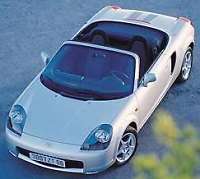
Mr. Nakagawa is responsible for the
development of both Celica and MR-S. While the recently launched Celica is
well received by the public, he seems to be more nervous about the MR-S.
He spent a lot of time to explain the new car to the press, stressed that
his mission was to bring back the agility that made the first generation
car so good.
He is
right. The second generation MR2 was originally praised for being
powerful. In normally aspirated form it produced 165hp (then rose to
173hp); Turbocharged version’s 225hp even earned it a name of
"mini-Ferrari". But the public’s enthusiasm quickly calmed down. People
started to complain about its grown up size and weight of around 1200kg.
Criticised its downgraded steering feel and cornering agility. Last year,
decline sales figure forced it withdrew from all markets except
Japan.
If you are
old enough, you might remember how exciting the first generation MR2 was.
It opened the eyes of European journalists, letting them to see the rising
sun’s ability to create exciting sports cars. The 16-valves engine was
powerful and years advancer than European. The mid-engined chassis
balanced and felt so good, with brisk performance to match. That was 1985.
14 years later, the third generation car is going back to the
basis.
The name
of the Mk3 might arise some confusion. In home market, it calls "MR-S"
rather than MR2, the latter is used in elsewhere. The "S" stands for
Spyder, in other words, Convertible.
In terms
of styling, the MR-S is another example demonstrating the incompetence of
the Japanese studio. Despite of the deliberate imitation on Porsche
Boxster (look at the front and rear lights !), its angular profile and
poor execution of details make it uncomfortable to look at. Next time
please ask the California studio (which styled Celica) or Brussel studio
(which penned Yaris) for help.
 The
cabin is tight fit, thanks to the size reduction. The instruments do what
they are intended to and no more. Lack of a stylish dashboard, lack of
high quality plastic as well as a decent trimming, you know price cut is
the second biggest mission of Mr. Nakagawa. The steering wheel is
adjustable in rake but not reach. The soft roof is operated manually,
although it stores neatly under a panel. So, inside and outside, the MR-S
does not deliver a good impression .... The
cabin is tight fit, thanks to the size reduction. The instruments do what
they are intended to and no more. Lack of a stylish dashboard, lack of
high quality plastic as well as a decent trimming, you know price cut is
the second biggest mission of Mr. Nakagawa. The steering wheel is
adjustable in rake but not reach. The soft roof is operated manually,
although it stores neatly under a panel. So, inside and outside, the MR-S
does not deliver a good impression ....
.... until
you fire the engine. The 1794 c.c. all-alloy 16-valver is equipped with
VVT-i like all other new engines from Toyota. The reduction of 200c.c.
drops power and torque to 140hp and 127 lbft respectively, but drivability
is not deteriorated. Nakagawa believes 1.8-litre is the best optimized
size for a four cylinder. It enables smaller radiator, smaller brakes,
narrower tyres .... in short, a lighter and more nimble
car.
Kerb
weight is just 975kg, exactly identical to the Mk1 MR2. This is a
remarkable achievement, considering the crash protection requirement for
2000 is far stricter than those of the 80s, and then the new car has more
powerful engine and a soft top. 14 years ago, it might not be the lightest
(cars such as Bertone X1/9 and Honda CRX might be lighter). Today, it is
some 100kg below the competitors.
 On the road, the
weight saving translate into excellent control. The mid-engined chassis
has first rate balance. Although it rides on MacPherson struts all round,
the good set-up works well to keep the wheels perpendicular to the black
top. The electric-assisted steering feels superbly communicative and well
weighted. 2.6 turns from lock to lock means quick response. More
important, the new MR-S corners with the agility and throttle
adjustability that remind us the first MR2 or Mazda MX-5. However, some
may describe it as "too tail happy", as it is easily prone to oversteer
like Lotus Elise, thanks to the suspension setup and 56% weight taking by
the rear axle. Well, such people just deserve to drive a boring BMW
Z3. On the road, the
weight saving translate into excellent control. The mid-engined chassis
has first rate balance. Although it rides on MacPherson struts all round,
the good set-up works well to keep the wheels perpendicular to the black
top. The electric-assisted steering feels superbly communicative and well
weighted. 2.6 turns from lock to lock means quick response. More
important, the new MR-S corners with the agility and throttle
adjustability that remind us the first MR2 or Mazda MX-5. However, some
may describe it as "too tail happy", as it is easily prone to oversteer
like Lotus Elise, thanks to the suspension setup and 56% weight taking by
the rear axle. Well, such people just deserve to drive a boring BMW
Z3.
In terms
of sheer handling, the little Toyota is unmatchable in its price range,
not even the ever-green Miata. But the latter has prettier styling and a
sense of originality. The MR-S, like the first 2 generations, are more
likely to be the choice for boy racers, who don't like art and philosophy.
Nevertheless, with the addition of convertible, the MR-S should appear to
the larger crowd.
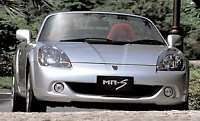 To most drivers, the biggest problem of MR-S is it is too keen on
oversteering. Skillful drivers may see that as engaging, but if they drive
the car in a raining night, they have to be very careful. Responding to
customer’s criticism, Toyota made a revision in August 2002. From
exterior, it looks like just a minor facelift which concentrates on
bumpers. However, underneath the skin there are 2 major
changes. To most drivers, the biggest problem of MR-S is it is too keen on
oversteering. Skillful drivers may see that as engaging, but if they drive
the car in a raining night, they have to be very careful. Responding to
customer’s criticism, Toyota made a revision in August 2002. From
exterior, it looks like just a minor facelift which concentrates on
bumpers. However, underneath the skin there are 2 major
changes.
Firstly,
to keep the rear tyres firmly glue on the road, they are enlarged from 15
to 16-inch in diameter and widened from 205/50 to 215/45. Moreover, a
mechanical LSD (limited-slip differential) is added to the rear axle,
regulating wheelspin. As a result, road testers found the revised MR-S
becomes much more sure-footed at the limit.
The second
major change is upgrading the gearbox - no matter the manual or the SMT
sequential manual - to 6-speed. The box is taken from Celica. It makes
better use of the limited torque of the 1.8-litre engine thus improves
performance slightly.
The look
and interior of MR-S was never outstanding. After 2 years, it starts
looking outdated. What a pity the revision do so little in these
area.
|
Model |
MR-S |
|
Layout |
Mid-engined,
Rwd |
|
Dimensions |
L / W / H / WB: 3885 /
1695 / 1235 / 2450 mm |
|
Engine |
Inline-4, dohc, 4v/cyl,
VVT |
|
Capacity |
1794
c.c. |
|
Power |
140
hp |
|
Torque |
127
lbft |
|
Transmission |
5M |
|
Suspension |
All:
strut |
|
Tyres |
F: 185/55 R15; R: 205/50
R15 |
|
Weight |
1076
kg |
|
Top
speed |
126
mph* |
|
0-60
mph |
7.5
sec* |
|
0-100
mph |
22.9
sec* |
Toyota Celica
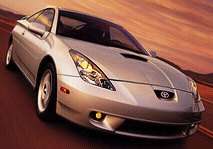 Unless you are Japanese, you must be amazed that the Celica has
entered its 7th generation. A quick calculation found Toyota launched a
new Celica every 4 and a half years, again hardly imagined by European and
American. Since the first Celica appeared in 1970, it is always the
biggest selling coupe in Toyota’s line-up, capturing those 20-something
buyers who want to have their first taste of a coupe. There were some
memorable milestones in its 30 years history, e.g., the third generation
gave birth to the six-cylinder Supra, the fourth generation shifted to
front-wheel-drive and 16-valves engine, then came the rally ace GT-4.
There were also some unfavourable moment, such as the launch of the
overweight and ugly fifth generation (I used to call it "Monster") and the
continuous sales decline during the life of the sixth generation. It’s
time to revive the Celica nameplate now. Unless you are Japanese, you must be amazed that the Celica has
entered its 7th generation. A quick calculation found Toyota launched a
new Celica every 4 and a half years, again hardly imagined by European and
American. Since the first Celica appeared in 1970, it is always the
biggest selling coupe in Toyota’s line-up, capturing those 20-something
buyers who want to have their first taste of a coupe. There were some
memorable milestones in its 30 years history, e.g., the third generation
gave birth to the six-cylinder Supra, the fourth generation shifted to
front-wheel-drive and 16-valves engine, then came the rally ace GT-4.
There were also some unfavourable moment, such as the launch of the
overweight and ugly fifth generation (I used to call it "Monster") and the
continuous sales decline during the life of the sixth generation. It’s
time to revive the Celica nameplate now.
Undoubtedly, the latest Celica has two things to make headline :
first, a striking look ; second, the new VVTL-i. Sadly, both are not the
efforts of Toyota itself. Across the Pacific, the American stylists of
Toyota’s California studio designed an aggressive body mirroring Ford’s
New Edge. The triangular headlights, a tiny nose intake and the scoop over
the bonnet are the main features at the front, while a sharp shoulder edge
dominates the rear half of the side. A rear wing is the signature of the
180hp version thus it is a must for
enthusiasts.
Underneath
the striking look, the new Celica is actually rather conservative.
Everything play safe : front-wheel drive remains unchanged, no GT-4
anymore, no V6, no turbo ... that means the car is not going to be as
exciting as Nissan Silvia, our current favourite. Why not build the car on
the Altezza (IS200) chassis ? I’m sure it would be fantastic to handle.
Why not gave it a chronographic gauge ?
The second
selling point is the VVTL-i equipped 2ZZ-GE power plant, that is, an all
new aluminium four cylinder developed with the help from Yamaha.
Displacing 1796c.c., it breaks the tradition since the third generation
that 2-litre engines must be used. It is smaller yet it has an aluminium
alloy block. The result is of course great weight saving, which lightens
the front wheels and improve handling. Yamaha has been known as an engine
expert in Japan and works as a consultant to other car makers. Its
experience was acquired from racing motorcycle (an arch-rival of Honda)
and once the Formula one engine program (not really Honda’s arch-rival).
Its famous creations range from both generations of Ford Taurus SHO
engines and the European Ford’s Zetec engine. Toyota’s first sports car,
2000GT of 1967, was also assembled by Yamaha.
Like many
high tech aluminium engine, the 2ZZ-GE gets Nikasil treatment instead of
using cast iron liner as a means to reduce friction and wear. Yamaha is
one of the few experts in the world having the Nikasil treatment
facilities (Ford’s Zetec is treated there), thus Toyota is eager to ask it
to assemble the 2ZZ-GE engine. Its work does not stop there. Base on
Toyota’s VVT-i variable valve timing system, Yamaha developed the VVTL-i
which also incorporates variable lift control. You must know that variable
lift is so important to top end power. Without it the new engine can never
reaches a maximum power of 180hp at 7600rpm. Basically, the mechanism is a
combination of the continuously phase-shifting variable timing (VVT-i) and
a 2-stage cam-changing variable lift like Honda’s VTEC, but the
implementation differs a bit from Honda thus avoid violating the rival’s
patent. Once exceeding 6,000rpm, the high speed cams take over and the
engine can rev for another 2 thousand rev.
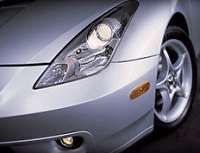 You may ask why the
Toyota’s unit does not pump out as many horsepower per litre as Honda’s
Civic Type R, Integra Type R or S2000. Very simple, Toyota’s engine is a
fully mass production engine without the hand-intensive treatment required
by the special Hondas, such as forged pistons / con-rod / counter weights
etc. Take a normal Integra GSR’s VTEC and you’ll notice the superiority of
Toyota’s VVTL-i, especially is low and mid-rpm torque, thanks to its
additional continuously variable valve timing. You may ask why the
Toyota’s unit does not pump out as many horsepower per litre as Honda’s
Civic Type R, Integra Type R or S2000. Very simple, Toyota’s engine is a
fully mass production engine without the hand-intensive treatment required
by the special Hondas, such as forged pistons / con-rod / counter weights
etc. Take a normal Integra GSR’s VTEC and you’ll notice the superiority of
Toyota’s VVTL-i, especially is low and mid-rpm torque, thanks to its
additional continuously variable valve timing.
On the
road, the 180hp Celica is pleasantly fast, despite of its reduced
displacement. Benefited by weight saving (the kerb weight is 1190kg) and a
close-ratio 6-speed manual, 0-60mph was timed in 6.8 sec by Road &
Track (Motor Trend even did that in 6.6 sec), 0-100mph was reached in 18.2
sec, very impressive. Nevertheless, don’t expect it to match the lightning
Silvia turbo or Fiat Coupe turbo, they do 0-100 in 14.2 sec and 14.5 sec
respectively.
If speed
is not the most important, the Celica should restore some ground with its
fine handling and ride. There is no trick in the conventional front
MacPherson struts and rear double wishbones, but the combination of
well-tuned spring / damper and lightweight engine lifts its performance.
Ride quality couldn’t be better for a coupe. Steering is surprisingly
quick and accurate, with plenty of feedback. As a FF its understeer is
well suppressed, although someone may ask for the ultimate fun as
experienced in a rear-drive Silvia or even the Altezza sedan. However, the
Celica’s balance, body roll, grip and brake are all no inferior to those
FR opponents.
The 180hp
engine for the GT-S model is revvy yet sufficiently torquey once you’re in
open road. Although its peak torque of 133 lbft arrives at sky-high
6,800rpm, the torque curve is very flat across the whole rev range.
However, I can’t help thinking that an addition of 200c.c. would have been
better coping with the competitors. The next thing I dream is a turbo,
perhaps from TRD. No way, I’m afraid only a new GT-4 could cope with
that.
Budget choice is also a
1.8-litre four, with the normal VVT-i instead of VVTL-i and output just
140hp and 125lbft. Please note that it is not a detuned version of the
180hp unit because it is developed by Toyota itself. Not only has cast
iron liners instead of Nikasil coating, its cylinder bore / stroke
dimension of 79.0 / 91.5mm also differs from the Yamaha engine’s 82.0 /
85.0mm. As reflected by its name, IZZ-FE, it is the one shared with the
new MR2 (MR-S). The basic engine has been reported as well short of power.
Both engines have the same 6-speed manual, which requires a strong hand.
An optional 4-speed E-shift automatic is well out of pace and
grace.
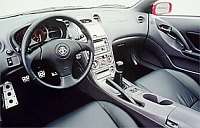 I personally
dislike the interior. It tries to be stylish but without using the proper
material to express the idea. The plasticky center console looks nothing
like alloy as it wished to be. The dials are well left behind the
chronographic era (finally the Japanese stylists found something superior
to their American colleagues). Overall speaking the interior is nothing
other than another mainstream coupe. In terms of comfort, the front seats
and driving position are comfortable, with ergonomically placing
instruments and controls. The rear seats are, again, lack of headroom thus
they are just "+2". I personally
dislike the interior. It tries to be stylish but without using the proper
material to express the idea. The plasticky center console looks nothing
like alloy as it wished to be. The dials are well left behind the
chronographic era (finally the Japanese stylists found something superior
to their American colleagues). Overall speaking the interior is nothing
other than another mainstream coupe. In terms of comfort, the front seats
and driving position are comfortable, with ergonomically placing
instruments and controls. The rear seats are, again, lack of headroom thus
they are just "+2".
Summing
all up, the new Celica is far better than the last 2 generations, no
matter in styling, performance and handling. On the down side, it does not
have some fundamental breakthroughs to make it a class winner. It appears
well to the majority, but might not be enough to set us on
fire.
|
Model |
Celica
GT |
Celica GT-S |
|
Layout |
Front-engined,
Fwd |
Front-engined,
Fwd. |
|
Dimensions |
L / W / H / WB: 4335 /
1735 / 1315 / 2600 mm |
|
Engine |
Inline-4, dohc, 4v/cyl,
VVT |
Inline-4, dohc, 4v/cyl,
VVT+VVL |
|
Capacity |
1794
c.c. |
1796
c.c. |
|
Power |
140
hp |
180
hp |
|
Torque |
125
lbft |
133
lbft |
|
Transmission |
6M |
6M |
|
Suspension |
F: strut / R: double
wishbones |
|
Tyres |
205/50
R16 |
205/50
R16 |
|
Weight |
1150
kg |
1190
kg |
|
Top
speed |
127 mph
(claimed) |
140 mph
(estimated) |
|
0-60
mph |
8.5 sec
(claimed) |
6.8
sec* |
|
0-100
mph |
N/A |
18.2
sec* |
Toyota Soarer / Lexus SC430
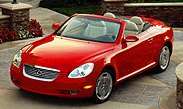 A running pillow. Truly, it looks like a running pillow. Toyota
said the design was chosen among proposals from its studios all over the
world, including the headquarters (think of IS200), the California-based
CALTY (whose track record includes the old SC and new Celica) and Brussels
(that pretty Yaris). Of course, the first to be ruled out was those who
penned the ugly IS200. Then, surprisingly, the management guys chose the
design from Brussels. In sketches it did look good, but after adaptation
to production - reducing the size of wheels, increasing the windscreen
incline angle, raising the level of bonnet and boot lid - the beautiful
profile was ruined and became a fat pillow. It is just another poor design
that looks good in concept stage but completely different in production
form. It is just another example that we car lovers foresaw a problem but
the management old men did not. Another problem is I cannot find a single
styling detail delivering a sense of elegance or prestige. They should
have chosen CALTY. A running pillow. Truly, it looks like a running pillow. Toyota
said the design was chosen among proposals from its studios all over the
world, including the headquarters (think of IS200), the California-based
CALTY (whose track record includes the old SC and new Celica) and Brussels
(that pretty Yaris). Of course, the first to be ruled out was those who
penned the ugly IS200. Then, surprisingly, the management guys chose the
design from Brussels. In sketches it did look good, but after adaptation
to production - reducing the size of wheels, increasing the windscreen
incline angle, raising the level of bonnet and boot lid - the beautiful
profile was ruined and became a fat pillow. It is just another poor design
that looks good in concept stage but completely different in production
form. It is just another example that we car lovers foresaw a problem but
the management old men did not. Another problem is I cannot find a single
styling detail delivering a sense of elegance or prestige. They should
have chosen CALTY.
The point
is clearer if you compare the new SC with the old one. While the former
looks odd, the latter is still handsome after 9 years (born 1992) even
though without much restyle. The same feeling extends to interior. Better
material used aside, the new styling is quite inconsistent - sometimes you
see a straight-and-cool center console housing a sound system with brush
alloy face, sometimes you see some light-color wood decorated in the
dashboard in an American-traditional shape, at the same time you face 3
cute dials as found in some funny cars. Too much character means no
character.
While
subjective sense is cruel to Lexus, as always, in objective sense it is
hard to fault. The new car has a much sportier dimension than the old one
- a massive 384 mm shorter, 24 mm wider, same height and have a wheelbase
71 mm shorter. The positive outcome is much improved driver appeal, also
thanks to the all-double-wishbones suspensions donated by GS sedan. The
bad news is a pair of laughable "plus 2" rear seats. You would be generous
to call them "dog seats". How small ? it might accommodate handicapped
passengers without legs. And I doubt if the boot, with the roof stored,
can accommodate a folded wheelchair.
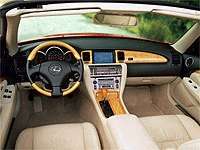 However, the
SLK-style aluminium roof is fabulous. Press a button and it will be
automatically folded and stored in the boot within 25 seconds. Unluckily,
when a Peugeot costing a third of its price has the same feature, driving
this Lexus is no longer as proud as it should have been. Sorry for going
back to subjective sense again, but honestly speaking subjective image
means a lot to this kind of prestige cars. However, the
SLK-style aluminium roof is fabulous. Press a button and it will be
automatically folded and stored in the boot within 25 seconds. Unluckily,
when a Peugeot costing a third of its price has the same feature, driving
this Lexus is no longer as proud as it should have been. Sorry for going
back to subjective sense again, but honestly speaking subjective image
means a lot to this kind of prestige cars.
Back to
cool mechanical spec and you’ll see the platform is actually a shortened
GS430, with the same creamy yet powerful 300-horsepower V8 and
silky-smooth yet clever 5-speed automatic, though there is no
Tiptronic-style E-shift. Few care, as the chassis still favour comfort
rather than handling although the old car was even more so. Lexus claimed
the body shell is stiffer than Jaguar XK8 Convertible but R&T’s
testers found the opposite, that’s probably because the Lexus rides on
softer suspension setting. They also felt the Jaguar more agile to change
direction while the Lexus felt bulkier and heavier. Steering is accurate
and vibration-free but could be a little numb. Unsurprisingly, the
positive side is smooth ride.
In this
respect, the Lexus follows tightly its traditional values of placing
refinement in first priority. That’s a bit sad after seeing the new
direction set by IS. Being a 300-horsepower coupe pricing near Jaguar XK8
and Mercedes CLK430 Conv., it’s driver appeal is inevitably letting us
down. Perhaps the car concentrates too much on American market - some
two-third of the 15,000 cars produced annually will destine there - and
fail to care the rest of the world, especially Europe. Ah ha, you know,
the old SC coupe was bounded in the America and
Japan.
Watch out
next year’s long-awaited (for 13 years) new Mercedes SL, with similar roof
and superior handling yet no compromise in ride comfort, I believe the
tri-star can sell double number of cars compare with the Lexus yet manage
to earn double profit margin per car. Believe or not
!
After all,
the new SC coupe is less desirable than the original appeared in 1992. I
think it cannot last as long.
|
Model |
Lexus
SC430 |
|
Layout |
Front-engined,
Rwd |
|
Dimensions |
L / W / H / WB: 4516 /
1829 / 1349 / 2619 mm |
|
Engine |
V8, dohc, 4v/cyl,
VVT. |
|
Capacity |
4293
c.c. |
|
Power |
300
hp |
|
Torque |
325
lbft |
|
Transmission |
5A |
|
Suspension |
All: double
wishbones |
|
Tyres |
245/40
ZR18 |
|
Weight |
1750
kg |
|
Top
speed |
155 mph
(limited) |
|
0-60
mph |
6.2
sec* |
|
0-100
mph |
15.2
sec* |
|
|

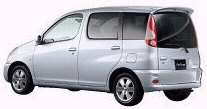 Funcargo is the MPV version of Vitz
(Yaris). Thanks to a massive growth in all dimensions but width (length
gains 250mm, height 180mm, wheelbase 130mm), the mini MPV has interior
space exceeding a Renault Scenic, which is a category higher in market
place. As usual, the seats offering different configurations, but the most
brilliant is that the rear seats can be folded completely into the
floor.
Funcargo is the MPV version of Vitz
(Yaris). Thanks to a massive growth in all dimensions but width (length
gains 250mm, height 180mm, wheelbase 130mm), the mini MPV has interior
space exceeding a Renault Scenic, which is a category higher in market
place. As usual, the seats offering different configurations, but the most
brilliant is that the rear seats can be folded completely into the
floor.
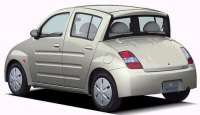 This car is all about yuppie.
Undoubtedly, the hemi-elliptic profile and sliding soft roof are inspired
by the late Citroen 2CV, while the channels recessed in the bonnet, boot
lid and doors are inspired by military vehicles. It looks dramatic,
especially is the contrast between the vertical rear window and swoopy
boot.
This car is all about yuppie.
Undoubtedly, the hemi-elliptic profile and sliding soft roof are inspired
by the late Citroen 2CV, while the channels recessed in the bonnet, boot
lid and doors are inspired by military vehicles. It looks dramatic,
especially is the contrast between the vertical rear window and swoopy
boot.
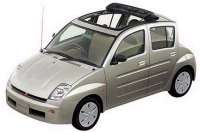 Mechanically, it is simply a repackaged
Yaris. As usual, yuppie packaging always result in compromised
practicality - poor aerodynamic drag, cramped rear leg room (thanks to
that vertical rear window), limited boot volume for a 3-box, lack of slide
rear seats, completely lack of lateral support from the flat seats, more
weight (= slower), automatic only (= even slower), higher price ... it’s
quite irrational, isn’t it?
Mechanically, it is simply a repackaged
Yaris. As usual, yuppie packaging always result in compromised
practicality - poor aerodynamic drag, cramped rear leg room (thanks to
that vertical rear window), limited boot volume for a 3-box, lack of slide
rear seats, completely lack of lateral support from the flat seats, more
weight (= slower), automatic only (= even slower), higher price ... it’s
quite irrational, isn’t it?
 "bB" stands for "Black Box". A strange
name it may be, but by no means meaningless. When you have a black box,
you are unlikely to care about its internal construction or how it work.
What you care is the outcome. Similarly, bB gives first priority to
practicality instead of styling, gimmicks etc. It really
works.
"bB" stands for "Black Box". A strange
name it may be, but by no means meaningless. When you have a black box,
you are unlikely to care about its internal construction or how it work.
What you care is the outcome. Similarly, bB gives first priority to
practicality instead of styling, gimmicks etc. It really
works.
 More accurately speaking, there is no
styling at all. It’s just a plain rectangular box with 5 big doors, high
roof and huge windows. This ensures remarkable cabin space as well as
visibility.
More accurately speaking, there is no
styling at all. It’s just a plain rectangular box with 5 big doors, high
roof and huge windows. This ensures remarkable cabin space as well as
visibility.
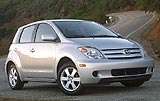
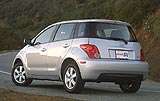
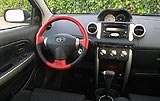
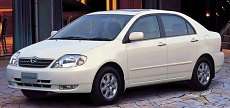 Corolla never
raised my curiosity. In car enthusiasts point of view, it always lived
under the shadow of arch-rival Honda Civic. Then, why were there so many
people buy the Corolla? what made it the no. 1 best seller in history,
with 28 million people purchased 8 generations of Corolla since 1966? From
the beginning, the Corolla’s winning formula has been reliability,
economical and good after-sale service. This latest Corolla is more or
less so.
Corolla never
raised my curiosity. In car enthusiasts point of view, it always lived
under the shadow of arch-rival Honda Civic. Then, why were there so many
people buy the Corolla? what made it the no. 1 best seller in history,
with 28 million people purchased 8 generations of Corolla since 1966? From
the beginning, the Corolla’s winning formula has been reliability,
economical and good after-sale service. This latest Corolla is more or
less so.
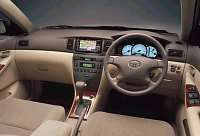 In terms of comfort and convenience,
the new Corolla rates high. Although rear passengers would have preferred
Civic’s flat floor, the Corolla has plenty of head and shoulder room to
match its arch-rival. Moreover, the high-mounted seats are easy to access,
though keen drivers might not like that. Seat cushion is thick and
comfortable, if not laterally supportive. The cabin is trimmed and built
with high-quality material and superb fit and finish, rather like a mini
Lexus. Nevertheless, design is very dull, washing out any good impression
we have already mentioned. Therefore the Corolla looks not a bit desirable
no matter from outside or inside.
In terms of comfort and convenience,
the new Corolla rates high. Although rear passengers would have preferred
Civic’s flat floor, the Corolla has plenty of head and shoulder room to
match its arch-rival. Moreover, the high-mounted seats are easy to access,
though keen drivers might not like that. Seat cushion is thick and
comfortable, if not laterally supportive. The cabin is trimmed and built
with high-quality material and superb fit and finish, rather like a mini
Lexus. Nevertheless, design is very dull, washing out any good impression
we have already mentioned. Therefore the Corolla looks not a bit desirable
no matter from outside or inside.
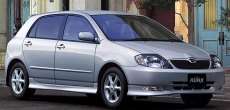

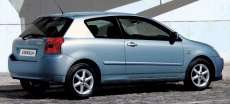 Fine tuning to
suspensions and steering are very important. Most cars in the D-segment
employ the same kind of suspensions (front struts, rear torsion-beam axle)
and steering (rack-and-pinion). What separate a good driver’s car from a
poor one is usually the fine tuning of every components. The Japanese
Corolla - as described above - was heavily criticized for its light
steering and soft suspensions. Now thoroughly retuned by Toyota’s Germany
R&D center, the European version of Corolla drives like another
car.
Fine tuning to
suspensions and steering are very important. Most cars in the D-segment
employ the same kind of suspensions (front struts, rear torsion-beam axle)
and steering (rack-and-pinion). What separate a good driver’s car from a
poor one is usually the fine tuning of every components. The Japanese
Corolla - as described above - was heavily criticized for its light
steering and soft suspensions. Now thoroughly retuned by Toyota’s Germany
R&D center, the European version of Corolla drives like another
car.
 Spacio is derived
directly from Corolla, that's why in overseas market it is called Corolla
Verso. In Toyota's dictionary, Verso means versatility, or in other words,
MPV.
Spacio is derived
directly from Corolla, that's why in overseas market it is called Corolla
Verso. In Toyota's dictionary, Verso means versatility, or in other words,
MPV.
 Don’t be fooled by its SUV look, Toyota Matrix is actually a
hatchback. It is derived from the Corolla, sharing the same floorpan
including suspensions and even the same 2600mm wheelbase. Apart from
taller body and higher ride height, it does not have any SUV
ingredient.
Don’t be fooled by its SUV look, Toyota Matrix is actually a
hatchback. It is derived from the Corolla, sharing the same floorpan
including suspensions and even the same 2600mm wheelbase. Apart from
taller body and higher ride height, it does not have any SUV
ingredient.
 GM has track record for selling restyled Toyota cars. In fact, the joint venture NUMMI plant in California
was set up to produce Toyota Corolla and Chevrelot Prism. Now Prism has
gone and the plant is converted to produce Pontiac Vibe, which is simply a
restyled Matrix. Pontiac designer did a great job here, making their
version more attractive to look than the Matrix.
GM has track record for selling restyled Toyota cars. In fact, the joint venture NUMMI plant in California
was set up to produce Toyota Corolla and Chevrelot Prism. Now Prism has
gone and the plant is converted to produce Pontiac Vibe, which is simply a
restyled Matrix. Pontiac designer did a great job here, making their
version more attractive to look than the Matrix.




 Avensis is a
typical Toyota product. Reliable, well-built, comfortable, easy to
drive.... but it also associates with descriptions such as "ugly",
"uninspiring", "lack of character" etc. In short, very
Toyota-like.
Avensis is a
typical Toyota product. Reliable, well-built, comfortable, easy to
drive.... but it also associates with descriptions such as "ugly",
"uninspiring", "lack of character" etc. In short, very
Toyota-like.


 Talking about 4-wheel-drive performance estates, you might think of Audi RS4 or S4
Avant. In Japan, there are more choices, also at lower price - Subaru
Legacy GTB, Mitsubishi Legnum VR4 and Toyota
Caldina.
Talking about 4-wheel-drive performance estates, you might think of Audi RS4 or S4
Avant. In Japan, there are more choices, also at lower price - Subaru
Legacy GTB, Mitsubishi Legnum VR4 and Toyota
Caldina.
 The engine is a 1998cc 16V Turbo,
pumping out 260hp and 239lbft, unchanged from the old car. The 4WD system
employs viscous coupling to distribute power between front and rear axle,
in addition to a Torsen limited-slip differential between the rear wheels.
Again, this is the same as the old Caldina and Celica GT-4. Transmission
remains just a 4-speed automatic, although it gets manual shift
pattern.
The engine is a 1998cc 16V Turbo,
pumping out 260hp and 239lbft, unchanged from the old car. The 4WD system
employs viscous coupling to distribute power between front and rear axle,
in addition to a Torsen limited-slip differential between the rear wheels.
Again, this is the same as the old Caldina and Celica GT-4. Transmission
remains just a 4-speed automatic, although it gets manual shift
pattern.
 Look at the new Camry, you won't love it from first sight, nor you
will hate it. It is as unadventurous and inoffensive as its 3
predecessors. If you have to praise it, you can still say the new Camry
looks a bit more sexy than ever, with sleeker lines running from nose to
tail. The slippery profile not only contributes to a good Cd. of 0.28 but
also hides its extra dimensions very well - now it offers more head room
and rear passenger legroom, thanks to 50mm longer wheelbase and 64mm
higher roof. Like the cold-war USA and USSR, Camry fights hard with Honda
Accord in "space race".
Look at the new Camry, you won't love it from first sight, nor you
will hate it. It is as unadventurous and inoffensive as its 3
predecessors. If you have to praise it, you can still say the new Camry
looks a bit more sexy than ever, with sleeker lines running from nose to
tail. The slippery profile not only contributes to a good Cd. of 0.28 but
also hides its extra dimensions very well - now it offers more head room
and rear passenger legroom, thanks to 50mm longer wheelbase and 64mm
higher roof. Like the cold-war USA and USSR, Camry fights hard with Honda
Accord in "space race".
 Good refinement
also comes from engines. Center of limelight is a new 2.4-litre
four-cylinder. With twin-balancer shafts it runs almost as smooth as a V6.
157 horsepower is not big number, but the adoption of VVT-i enhance torque
delivery across a wide band, making it an easy-going companion. The engine
is made of aluminium block and head, with magnesium cam cover and plastic
intake manifold to make the lightest in class.
Good refinement
also comes from engines. Center of limelight is a new 2.4-litre
four-cylinder. With twin-balancer shafts it runs almost as smooth as a V6.
157 horsepower is not big number, but the adoption of VVT-i enhance torque
delivery across a wide band, making it an easy-going companion. The engine
is made of aluminium block and head, with magnesium cam cover and plastic
intake manifold to make the lightest in class.
 Of course, if our
choices are not limited to Toyota (some people only trust Toyota's
reliability and good servicing), Ford Mondeo is still the first priority.
Although we said the new Camry has improved handling, with linear and
accurate steering, tauter control and strong brakes, it is still a car
designed for comfort and driving ease rather than driving fun. Mrs.
Robinson and Mr. Grey might enjoy that kind of fuss-free driving, but
those who really Love driving will find the steering still lack of
feedback, body control is not good in twisty roads and it tends to
understeer early. In short, it does not feel as agile as the best European
sedans as well as Nissan's new Altima.
Of course, if our
choices are not limited to Toyota (some people only trust Toyota's
reliability and good servicing), Ford Mondeo is still the first priority.
Although we said the new Camry has improved handling, with linear and
accurate steering, tauter control and strong brakes, it is still a car
designed for comfort and driving ease rather than driving fun. Mrs.
Robinson and Mr. Grey might enjoy that kind of fuss-free driving, but
those who really Love driving will find the steering still lack of
feedback, body control is not good in twisty roads and it tends to
understeer early. In short, it does not feel as agile as the best European
sedans as well as Nissan's new Altima.
 I want to write more about the new ES300, but I can't. Since the
car is still derived directly from the mainstream Camry, it is as
technically uninteresting as its 2 predecessors. How uninteresting ? first
of all, it is the last car in the world riding on MacPherson struts at
each corner while dare to declare itself as a prestige car. For the cheap
Camry, this is forgivable, but for Lexus it sounds like a joke. Well, many
BMW uses struts up front and Alfa 156 uses them at rear axle, but at both
front and rear ? ES300's chassis is the last breed of Jurassic
dinosaur.
I want to write more about the new ES300, but I can't. Since the
car is still derived directly from the mainstream Camry, it is as
technically uninteresting as its 2 predecessors. How uninteresting ? first
of all, it is the last car in the world riding on MacPherson struts at
each corner while dare to declare itself as a prestige car. For the cheap
Camry, this is forgivable, but for Lexus it sounds like a joke. Well, many
BMW uses struts up front and Alfa 156 uses them at rear axle, but at both
front and rear ? ES300's chassis is the last breed of Jurassic
dinosaur.
 Perhaps the new
exterior styling can score back some points ? unlike its predecessor, it
was styled in Japan instead of California, but it has an aircraft-style
profile and radical nose to make you believe it was done in the USA.
However, the organic grilles and headlights are unlikely to withstand the
test of time, and they devoid of any sense of prestige. The last ES300
feels more expensive.
Perhaps the new
exterior styling can score back some points ? unlike its predecessor, it
was styled in Japan instead of California, but it has an aircraft-style
profile and radical nose to make you believe it was done in the USA.
However, the organic grilles and headlights are unlikely to withstand the
test of time, and they devoid of any sense of prestige. The last ES300
feels more expensive.
 Avalon (or Pronard
for Japan) is built in the Kentucky plant alongside Camry on which it is
based. Basically, it is a grown-up Camry with massive increment of cabin
space enable it to be classified as full-size sedan by EPA regulations. In
other words, it targets Big 3’s products (especially the sales-topping
Buick LeSabre) instead of other Japanese cars.
Avalon (or Pronard
for Japan) is built in the Kentucky plant alongside Camry on which it is
based. Basically, it is a grown-up Camry with massive increment of cabin
space enable it to be classified as full-size sedan by EPA regulations. In
other words, it targets Big 3’s products (especially the sales-topping
Buick LeSabre) instead of other Japanese cars.
 Carrying more weight than the Camry, it
requires more power. Toyota gave it Lexus ES300’s V6 (that is, Camry’s V6
plus VVT-i). 210 horsepower and 210 lbft of torque. 4-speed automatic is
smooth, although column shifter is tricky to select the correct
gear.
Carrying more weight than the Camry, it
requires more power. Toyota gave it Lexus ES300’s V6 (that is, Camry’s V6
plus VVT-i). 210 horsepower and 210 lbft of torque. 4-speed automatic is
smooth, although column shifter is tricky to select the correct
gear.


 So, what you can expect from the Solara
is spacious cabin, good build quality and remarkable comfort, just like
the Carmy. It is powered by a new 3.3-litre V6 from Lexus RX330. 225
horsepower might be a little underpowered by today's standard, but it
remains smooth and quiet in Toyota's tradition. Because this is a
comfort-biased coupe, the V6 can partner with only a 5-speed automatic
from the sedan, although ratios have been tightened to improve
acceleration. It can therefore go from rest to 60mph in a brisk 7.0
seconds. A drag coefficient of 0.29 also allows it to slip easily into air
stream.
So, what you can expect from the Solara
is spacious cabin, good build quality and remarkable comfort, just like
the Carmy. It is powered by a new 3.3-litre V6 from Lexus RX330. 225
horsepower might be a little underpowered by today's standard, but it
remains smooth and quiet in Toyota's tradition. Because this is a
comfort-biased coupe, the V6 can partner with only a 5-speed automatic
from the sedan, although ratios have been tightened to improve
acceleration. It can therefore go from rest to 60mph in a brisk 7.0
seconds. A drag coefficient of 0.29 also allows it to slip easily into air
stream.
 Enter the cabin, after disappointed
with the sedan-like dashboard design, you will start appreciating the good
materials and fit and finish as well as vast of space. Only taller
passengers at the back will find their heads toughing the fastback roof.
Sound insulation is almost as effective as the
sedan.
Enter the cabin, after disappointed
with the sedan-like dashboard design, you will start appreciating the good
materials and fit and finish as well as vast of space. Only taller
passengers at the back will find their heads toughing the fastback roof.
Sound insulation is almost as effective as the
sedan.
 This is the
Japanese interpretation of "sports sedan" - a twin-turbo 2.5-litre
straight six pumps out 280 horsepower, providing acceleration eclipsing
many sports cars. The chassis is not very stiff by today's standard, but
compensate that by riding on stiff springs results in good roll-control in
corner. The steering is surprisingly heavy by Japanese standard, but apart
from kickback it offers no feel. Though the car is rear-drive and have
perfect double-wishbones suspensions all round, it understeers rather
early and spoil any enthusiasm to attack corner. When you call for driving
fun, it says to you, "I'm a luxury sedan". Then you ask for a supple ride
and it replied, "I'm a sports car". In contrast, a BMW will satisfy both
requirements. Fly the Mark II on highway and you can sense the cross wind,
shake and roll due to aerodynamic lift.
This is the
Japanese interpretation of "sports sedan" - a twin-turbo 2.5-litre
straight six pumps out 280 horsepower, providing acceleration eclipsing
many sports cars. The chassis is not very stiff by today's standard, but
compensate that by riding on stiff springs results in good roll-control in
corner. The steering is surprisingly heavy by Japanese standard, but apart
from kickback it offers no feel. Though the car is rear-drive and have
perfect double-wishbones suspensions all round, it understeers rather
early and spoil any enthusiasm to attack corner. When you call for driving
fun, it says to you, "I'm a luxury sedan". Then you ask for a supple ride
and it replied, "I'm a sports car". In contrast, a BMW will satisfy both
requirements. Fly the Mark II on highway and you can sense the cross wind,
shake and roll due to aerodynamic lift.
 Admittedly, Toyota has been changing.
IS200 was made according to European taste and tuned in Nurburgring before
appearing in show room. But it is a copy cat. What the Mark II has is a
unique character - no matter you like it or not. It won't appeal to most
of us - otherwise Toyota won't bound its sales in Japan - but it is a
living history for Japanese traditional sports sedan. A history started in
1968 and entered the 9th generation last year. Its sister car Cresta has
already announced dead. Another sister Chaser is also dying. The same goes
for Nissan's similar Laurel. Everybody can see this kind of cars will
eventually die under the threat of European prestige
marques.
Admittedly, Toyota has been changing.
IS200 was made according to European taste and tuned in Nurburgring before
appearing in show room. But it is a copy cat. What the Mark II has is a
unique character - no matter you like it or not. It won't appeal to most
of us - otherwise Toyota won't bound its sales in Japan - but it is a
living history for Japanese traditional sports sedan. A history started in
1968 and entered the 9th generation last year. Its sister car Cresta has
already announced dead. Another sister Chaser is also dying. The same goes
for Nissan's similar Laurel. Everybody can see this kind of cars will
eventually die under the threat of European prestige
marques.
 The days left for traditional Japanese-taste luxury cars are
limited. Toyota no longer needs Chaser and Cresta as supporting roles to
Mark II, therefore both were replaced by a European-style new comer,
Verossa. From the name which consists of Italian words "Vero" (True) and
"Rossa" (Red) you’ll see this car tends to attract younger customers who
used to prefer the dynamic image of BMW 3-series and Audi A4. In fact, the
radical styling has strong Latin influence. Not unlike Alfa Romeo, but
even more exaggerate, something approaching Zagato. Officially it is said
as designed in Japan, but who knows whether Zagato gave any inspiration ?
you know, Toyota is the biggest client of Zagato.
The days left for traditional Japanese-taste luxury cars are
limited. Toyota no longer needs Chaser and Cresta as supporting roles to
Mark II, therefore both were replaced by a European-style new comer,
Verossa. From the name which consists of Italian words "Vero" (True) and
"Rossa" (Red) you’ll see this car tends to attract younger customers who
used to prefer the dynamic image of BMW 3-series and Audi A4. In fact, the
radical styling has strong Latin influence. Not unlike Alfa Romeo, but
even more exaggerate, something approaching Zagato. Officially it is said
as designed in Japan, but who knows whether Zagato gave any inspiration ?
you know, Toyota is the biggest client of Zagato.
 Appeared in 1955,
"Crown" is the oldest nameplate in Toyota’s current line-up. Generation
after generation, today’s Crown is still the most popular company car in
Japan, which is good, but its presence is still bounded in domestic market
and South East Asia, which is less good. One word summarise its character
- Conservative. To please Japanese company executives and businessmen, you
know, it HAS to be conservative in styling and trimming. It has to ride as
supple as magic carpet, offering independent audio, climate and lighting
controls for the rear passenger. In contrast, driving pleasure is not very
important.
Appeared in 1955,
"Crown" is the oldest nameplate in Toyota’s current line-up. Generation
after generation, today’s Crown is still the most popular company car in
Japan, which is good, but its presence is still bounded in domestic market
and South East Asia, which is less good. One word summarise its character
- Conservative. To please Japanese company executives and businessmen, you
know, it HAS to be conservative in styling and trimming. It has to ride as
supple as magic carpet, offering independent audio, climate and lighting
controls for the rear passenger. In contrast, driving pleasure is not very
important.
 The cabin also looks fresh. Lexus-like
back-lit gauges looks cool. Center console has a unique shape and is no
longer taxi-like. Two-tone colours match very well with wood decoration
and leather trimming, although I suspect the wood is fake. Fit and finish
is first rate, so is the quality of material. My only complain is the
dull-looking 4-spoke steering wheel. There’s plenty of space for front and
rear passengers, the latter also enjoy independent audio and climate
control, reading lamps and a small refrigerator behind the arm rest.
Overall speaking, it’s an enjoyable place to spend hours of long
journey.
The cabin also looks fresh. Lexus-like
back-lit gauges looks cool. Center console has a unique shape and is no
longer taxi-like. Two-tone colours match very well with wood decoration
and leather trimming, although I suspect the wood is fake. Fit and finish
is first rate, so is the quality of material. My only complain is the
dull-looking 4-spoke steering wheel. There’s plenty of space for front and
rear passengers, the latter also enjoy independent audio and climate
control, reading lamps and a small refrigerator behind the arm rest.
Overall speaking, it’s an enjoyable place to spend hours of long
journey.
 Although the range-topping Majesta is
powered by Lexus’s 4-litre V8, most other Crowns are likely to be ordered
with 3.0 inline-6. This 24-valver is actually the same as Supra and Lexus
GS300. No matter with or without direct-injection, it output 220
horsepower and 217 lbft of torque. As in Lexus GS, it is silky smooth and
quiet. Predictably, Toyota provides no option for manual gearbox, but
there are two electronic automatic for choose: 4-speed automatic is
smoother; 5-speed Super ECT (with Tiptronic style manual override mode) is
quicker.
Although the range-topping Majesta is
powered by Lexus’s 4-litre V8, most other Crowns are likely to be ordered
with 3.0 inline-6. This 24-valver is actually the same as Supra and Lexus
GS300. No matter with or without direct-injection, it output 220
horsepower and 217 lbft of torque. As in Lexus GS, it is silky smooth and
quiet. Predictably, Toyota provides no option for manual gearbox, but
there are two electronic automatic for choose: 4-speed automatic is
smoother; 5-speed Super ECT (with Tiptronic style manual override mode) is
quicker. 

 BMW 02 Series and
3 Series are one of the miracles in motor history. They proved there are
millions of keen drivers that would pay premium price and sacrifice a
little bit passenger comfort for a sedan with superb handling and
performance. For thirty years, BMW dominated this market segment without
any serious challenge. As the market is expanding, Audi A4 and Alfa Romeo
entered the market, both with great success. Toyota, which has already
created the 5-Series-challenging GS400, also wants to have a slice in this
market.
BMW 02 Series and
3 Series are one of the miracles in motor history. They proved there are
millions of keen drivers that would pay premium price and sacrifice a
little bit passenger comfort for a sedan with superb handling and
performance. For thirty years, BMW dominated this market segment without
any serious challenge. As the market is expanding, Audi A4 and Alfa Romeo
entered the market, both with great success. Toyota, which has already
created the 5-Series-challenging GS400, also wants to have a slice in this
market.
 Don’t celebrate too early. BMW is
introducing a 3.0-litre straight six into the 3-series as well. This
engine will replace the 2.8 unit in all BMW models. It retains the basic
construction of the current 2.5 and 2.8 unit, that means all aluminium
construction and Double Vanos VVT. The extra displacement boost power and
torque to 231 hp (DIN) and 221 lbft (DIN) respectively. In SAE scale, it
is 225 hp and 214 lbft. So the new 330i will be at least as quick as the
IS300.
Don’t celebrate too early. BMW is
introducing a 3.0-litre straight six into the 3-series as well. This
engine will replace the 2.8 unit in all BMW models. It retains the basic
construction of the current 2.5 and 2.8 unit, that means all aluminium
construction and Double Vanos VVT. The extra displacement boost power and
torque to 231 hp (DIN) and 221 lbft (DIN) respectively. In SAE scale, it
is 225 hp and 214 lbft. So the new 330i will be at least as quick as the
IS300.
 Progres could be
said as the forerunner of Altezza. It was launched half a year earlier
than the latter, but unlike its sister, sales is bounded in Japan. While
the Altezza represents a new idea, the Progres conforms to the traditional
value. Although based on the same rear-wheel-drive platform, its wheelbase
has an extra 110mm to provide the amount of cabin space that a luxurious
sedan deserve. Similarly, the overall length is 100mm longer than Altezza,
while the 1700mm width is 20mm short of its sister, once again prove that
it is not designed for ultimate driving excitement.
Progres could be
said as the forerunner of Altezza. It was launched half a year earlier
than the latter, but unlike its sister, sales is bounded in Japan. While
the Altezza represents a new idea, the Progres conforms to the traditional
value. Although based on the same rear-wheel-drive platform, its wheelbase
has an extra 110mm to provide the amount of cabin space that a luxurious
sedan deserve. Similarly, the overall length is 100mm longer than Altezza,
while the 1700mm width is 20mm short of its sister, once again prove that
it is not designed for ultimate driving excitement.
 Toyota Brevis is
the twins sister of Progres, hence an enlarged Lexus IS. Unlike Progres,
the new Brevis aims at younger customers and compete directly with imports
like BMW 3-series and Mercedes C-class. Basically, the chassis and
powertrains are identical to Progres. What makes it more appealing is a
(relatively) handsome exterior styling and a beautifully trimmed interior.
The stylish center console houses a LCD monitor and an alloy-effect sound
system consists of on-dash CD changer, DVD and MD, with 7 speakers on top
model. Besides, like Ford Taurus, it provides power pedals which can
adjust across a range of 70mm to suit drivers of different height. Better
than Taurus, the position of pedal, steering wheel and driver’s seat are
memorised.
Toyota Brevis is
the twins sister of Progres, hence an enlarged Lexus IS. Unlike Progres,
the new Brevis aims at younger customers and compete directly with imports
like BMW 3-series and Mercedes C-class. Basically, the chassis and
powertrains are identical to Progres. What makes it more appealing is a
(relatively) handsome exterior styling and a beautifully trimmed interior.
The stylish center console houses a LCD monitor and an alloy-effect sound
system consists of on-dash CD changer, DVD and MD, with 7 speakers on top
model. Besides, like Ford Taurus, it provides power pedals which can
adjust across a range of 70mm to suit drivers of different height. Better
than Taurus, the position of pedal, steering wheel and driver’s seat are
memorised.
 BMW 5-series, the untouchable. Since 1996, the 5-series has been
the benchmark of the class, offering driver appeal as well as refinement
that competitors hardly match. Among many challengers, Toyota Aristo comes
closest to the benchmark.
BMW 5-series, the untouchable. Since 1996, the 5-series has been
the benchmark of the class, offering driver appeal as well as refinement
that competitors hardly match. Among many challengers, Toyota Aristo comes
closest to the benchmark.
 One of the most successful Japanese cars in history is Lexus LS400.
When it was launched in 1989, many Western automotive industrial insiders
could not virtually believe what the first attempt from Japan had done:
very high quality, all-round refinement, ultra-smooth and near-silent V8,
comfortable ride ... plus a bargain price that scared Mercedes and
BMW.
One of the most successful Japanese cars in history is Lexus LS400.
When it was launched in 1989, many Western automotive industrial insiders
could not virtually believe what the first attempt from Japan had done:
very high quality, all-round refinement, ultra-smooth and near-silent V8,
comfortable ride ... plus a bargain price that scared Mercedes and
BMW.  However, because of
rising Yen and rising production cost in Japan, the price of LS400
gradually increased throughout the first half of the 90s; simultaneously,
Mercedes, BMW, Audi and Jaguar fought back with newer models. LS lost its
top spot in sales chart. The ’95 and ’97 makeover did stopped sales
decline temporarily, but only an all-new LS can put Lexus back in
limelight.
However, because of
rising Yen and rising production cost in Japan, the price of LS400
gradually increased throughout the first half of the 90s; simultaneously,
Mercedes, BMW, Audi and Jaguar fought back with newer models. LS lost its
top spot in sales chart. The ’95 and ’97 makeover did stopped sales
decline temporarily, but only an all-new LS can put Lexus back in
limelight.
 The exterior styling has a strong
resemblance to (not LS400, but) the previous generation Mercedes S-class,
once again demonstrating the incapability of Japanese designers. It’s not
a surprise, because its predecessor was already criticised as copying an
older S-class. Now we can predict how the next generation LS will look
like ....
The exterior styling has a strong
resemblance to (not LS400, but) the previous generation Mercedes S-class,
once again demonstrating the incapability of Japanese designers. It’s not
a surprise, because its predecessor was already criticised as copying an
older S-class. Now we can predict how the next generation LS will look
like ....
 The new-found dimensions benefit a
roomy cabin which is equipped with many high-tech equipment just like the
new S-class, such as keyless entry, DVD-ROM GPS navigation, voice phone,
heated and cooled front seats, heated and massager-incorporated rear seats
and parking sensor. Ergonomic wise, however, it is not as impressive.
There are many switches placed in a confusing manner. Using touch screen
to control radio and adjust climate control is rather annoying and
unnecessary. In terms of material and craftsmanship, the Lexus’s leather
and wood-rich cabin is competitive, although never feels as prestige as
Audi and Jaguar.
The new-found dimensions benefit a
roomy cabin which is equipped with many high-tech equipment just like the
new S-class, such as keyless entry, DVD-ROM GPS navigation, voice phone,
heated and cooled front seats, heated and massager-incorporated rear seats
and parking sensor. Ergonomic wise, however, it is not as impressive.
There are many switches placed in a confusing manner. Using touch screen
to control radio and adjust climate control is rather annoying and
unnecessary. In terms of material and craftsmanship, the Lexus’s leather
and wood-rich cabin is competitive, although never feels as prestige as
Audi and Jaguar.

 The
cabin is tight fit, thanks to the size reduction. The instruments do what
they are intended to and no more. Lack of a stylish dashboard, lack of
high quality plastic as well as a decent trimming, you know price cut is
the second biggest mission of Mr. Nakagawa. The steering wheel is
adjustable in rake but not reach. The soft roof is operated manually,
although it stores neatly under a panel. So, inside and outside, the MR-S
does not deliver a good impression ....
The
cabin is tight fit, thanks to the size reduction. The instruments do what
they are intended to and no more. Lack of a stylish dashboard, lack of
high quality plastic as well as a decent trimming, you know price cut is
the second biggest mission of Mr. Nakagawa. The steering wheel is
adjustable in rake but not reach. The soft roof is operated manually,
although it stores neatly under a panel. So, inside and outside, the MR-S
does not deliver a good impression ....
 On the road, the
weight saving translate into excellent control. The mid-engined chassis
has first rate balance. Although it rides on MacPherson struts all round,
the good set-up works well to keep the wheels perpendicular to the black
top. The electric-assisted steering feels superbly communicative and well
weighted. 2.6 turns from lock to lock means quick response. More
important, the new MR-S corners with the agility and throttle
adjustability that remind us the first MR2 or Mazda MX-5. However, some
may describe it as "too tail happy", as it is easily prone to oversteer
like Lotus Elise, thanks to the suspension setup and 56% weight taking by
the rear axle. Well, such people just deserve to drive a boring BMW
Z3.
On the road, the
weight saving translate into excellent control. The mid-engined chassis
has first rate balance. Although it rides on MacPherson struts all round,
the good set-up works well to keep the wheels perpendicular to the black
top. The electric-assisted steering feels superbly communicative and well
weighted. 2.6 turns from lock to lock means quick response. More
important, the new MR-S corners with the agility and throttle
adjustability that remind us the first MR2 or Mazda MX-5. However, some
may describe it as "too tail happy", as it is easily prone to oversteer
like Lotus Elise, thanks to the suspension setup and 56% weight taking by
the rear axle. Well, such people just deserve to drive a boring BMW
Z3.
 To most drivers, the biggest problem of MR-S is it is too keen on
oversteering. Skillful drivers may see that as engaging, but if they drive
the car in a raining night, they have to be very careful. Responding to
customer’s criticism, Toyota made a revision in August 2002. From
exterior, it looks like just a minor facelift which concentrates on
bumpers. However, underneath the skin there are 2 major
changes.
To most drivers, the biggest problem of MR-S is it is too keen on
oversteering. Skillful drivers may see that as engaging, but if they drive
the car in a raining night, they have to be very careful. Responding to
customer’s criticism, Toyota made a revision in August 2002. From
exterior, it looks like just a minor facelift which concentrates on
bumpers. However, underneath the skin there are 2 major
changes.
 Unless you are Japanese, you must be amazed that the Celica has
entered its 7th generation. A quick calculation found Toyota launched a
new Celica every 4 and a half years, again hardly imagined by European and
American. Since the first Celica appeared in 1970, it is always the
biggest selling coupe in Toyota’s line-up, capturing those 20-something
buyers who want to have their first taste of a coupe. There were some
memorable milestones in its 30 years history, e.g., the third generation
gave birth to the six-cylinder Supra, the fourth generation shifted to
front-wheel-drive and 16-valves engine, then came the rally ace GT-4.
There were also some unfavourable moment, such as the launch of the
overweight and ugly fifth generation (I used to call it "Monster") and the
continuous sales decline during the life of the sixth generation. It’s
time to revive the Celica nameplate now.
Unless you are Japanese, you must be amazed that the Celica has
entered its 7th generation. A quick calculation found Toyota launched a
new Celica every 4 and a half years, again hardly imagined by European and
American. Since the first Celica appeared in 1970, it is always the
biggest selling coupe in Toyota’s line-up, capturing those 20-something
buyers who want to have their first taste of a coupe. There were some
memorable milestones in its 30 years history, e.g., the third generation
gave birth to the six-cylinder Supra, the fourth generation shifted to
front-wheel-drive and 16-valves engine, then came the rally ace GT-4.
There were also some unfavourable moment, such as the launch of the
overweight and ugly fifth generation (I used to call it "Monster") and the
continuous sales decline during the life of the sixth generation. It’s
time to revive the Celica nameplate now.
 You may ask why the
Toyota’s unit does not pump out as many horsepower per litre as Honda’s
Civic Type R, Integra Type R or S2000. Very simple, Toyota’s engine is a
fully mass production engine without the hand-intensive treatment required
by the special Hondas, such as forged pistons / con-rod / counter weights
etc. Take a normal Integra GSR’s VTEC and you’ll notice the superiority of
Toyota’s VVTL-i, especially is low and mid-rpm torque, thanks to its
additional continuously variable valve timing.
You may ask why the
Toyota’s unit does not pump out as many horsepower per litre as Honda’s
Civic Type R, Integra Type R or S2000. Very simple, Toyota’s engine is a
fully mass production engine without the hand-intensive treatment required
by the special Hondas, such as forged pistons / con-rod / counter weights
etc. Take a normal Integra GSR’s VTEC and you’ll notice the superiority of
Toyota’s VVTL-i, especially is low and mid-rpm torque, thanks to its
additional continuously variable valve timing.
 I personally
dislike the interior. It tries to be stylish but without using the proper
material to express the idea. The plasticky center console looks nothing
like alloy as it wished to be. The dials are well left behind the
chronographic era (finally the Japanese stylists found something superior
to their American colleagues). Overall speaking the interior is nothing
other than another mainstream coupe. In terms of comfort, the front seats
and driving position are comfortable, with ergonomically placing
instruments and controls. The rear seats are, again, lack of headroom thus
they are just "+2".
I personally
dislike the interior. It tries to be stylish but without using the proper
material to express the idea. The plasticky center console looks nothing
like alloy as it wished to be. The dials are well left behind the
chronographic era (finally the Japanese stylists found something superior
to their American colleagues). Overall speaking the interior is nothing
other than another mainstream coupe. In terms of comfort, the front seats
and driving position are comfortable, with ergonomically placing
instruments and controls. The rear seats are, again, lack of headroom thus
they are just "+2".
 A running pillow. Truly, it looks like a running pillow. Toyota
said the design was chosen among proposals from its studios all over the
world, including the headquarters (think of IS200), the California-based
CALTY (whose track record includes the old SC and new Celica) and Brussels
(that pretty Yaris). Of course, the first to be ruled out was those who
penned the ugly IS200. Then, surprisingly, the management guys chose the
design from Brussels. In sketches it did look good, but after adaptation
to production - reducing the size of wheels, increasing the windscreen
incline angle, raising the level of bonnet and boot lid - the beautiful
profile was ruined and became a fat pillow. It is just another poor design
that looks good in concept stage but completely different in production
form. It is just another example that we car lovers foresaw a problem but
the management old men did not. Another problem is I cannot find a single
styling detail delivering a sense of elegance or prestige. They should
have chosen CALTY.
A running pillow. Truly, it looks like a running pillow. Toyota
said the design was chosen among proposals from its studios all over the
world, including the headquarters (think of IS200), the California-based
CALTY (whose track record includes the old SC and new Celica) and Brussels
(that pretty Yaris). Of course, the first to be ruled out was those who
penned the ugly IS200. Then, surprisingly, the management guys chose the
design from Brussels. In sketches it did look good, but after adaptation
to production - reducing the size of wheels, increasing the windscreen
incline angle, raising the level of bonnet and boot lid - the beautiful
profile was ruined and became a fat pillow. It is just another poor design
that looks good in concept stage but completely different in production
form. It is just another example that we car lovers foresaw a problem but
the management old men did not. Another problem is I cannot find a single
styling detail delivering a sense of elegance or prestige. They should
have chosen CALTY.
 However, the
SLK-style aluminium roof is fabulous. Press a button and it will be
automatically folded and stored in the boot within 25 seconds. Unluckily,
when a Peugeot costing a third of its price has the same feature, driving
this Lexus is no longer as proud as it should have been. Sorry for going
back to subjective sense again, but honestly speaking subjective image
means a lot to this kind of prestige cars.
However, the
SLK-style aluminium roof is fabulous. Press a button and it will be
automatically folded and stored in the boot within 25 seconds. Unluckily,
when a Peugeot costing a third of its price has the same feature, driving
this Lexus is no longer as proud as it should have been. Sorry for going
back to subjective sense again, but honestly speaking subjective image
means a lot to this kind of prestige cars.